




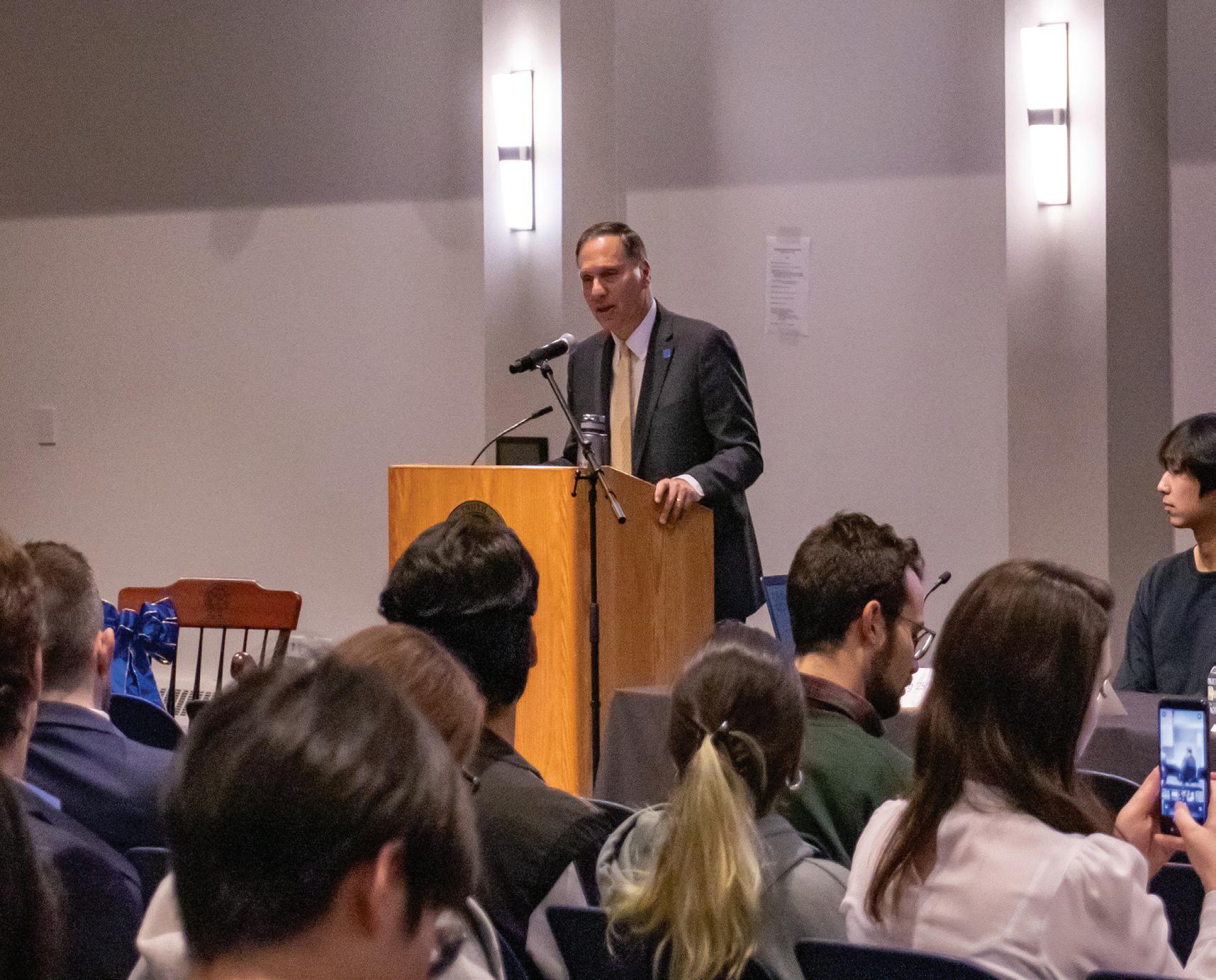
■ Brandeis community members were informed of the resignation of the ninth University president by the Board of Trustees.
On Sept. 25, the Brandeis community was shocked as a new email entered their inbox. The email, written by Chair of the Board of Trustees Lisa R. Kranc ’75, was sent out at 9:42 a.m. and announced the resignation of University President Ronald Liebowitz. This news came just two days after the announcement of the faculty vote of no confidence and one day after the conclusion of the Board of Trustees fall meetings.
Liebowitz will be stepping down from his position on Nov. 1, a surprise to many as this date falls prior to the conclusion of the fall 2024 semester. In the email, Kranc shared that “the Brandeis Board of Trustees appointed [Liebowitz] president emeritus,” and explained that the implementation of this title will allow him to “continue to advocate for Brandeis and its values.”
The email went on to acknowledge Liebowitz for his contributions to the Brandeis community, emphasizing his work “speaking out against antisemitism in our world and on college campuses.” Kranc also emphasized his work reconnecting with alumni globally through the celebrations of Brandeis’ 75th anniversary.
Following the acknowledgement of Liebowitz’s departure, the board informed the community about the appointment of new University interim president, Brandeis alumnus Dr. Arthur E. Levine ’70, who will be stepping into the role on Nov. 1. The email stated that “[Levine] looks forward to meeting members of the Brandeis community in the coming weeks” and highlighted some of his past experiences, such as holding the position of president of Teachers College at Columbia University.
16 minutes after Kranc’s email, the Brandeis community received one from Liebowitz. In his email, Liebowitz explained that the decision to resign was not an easy choice to make, as he did so with “mixed emotions” due to the “great meaning” the University holds, “especially at this time.” However, Liebowitz stated that
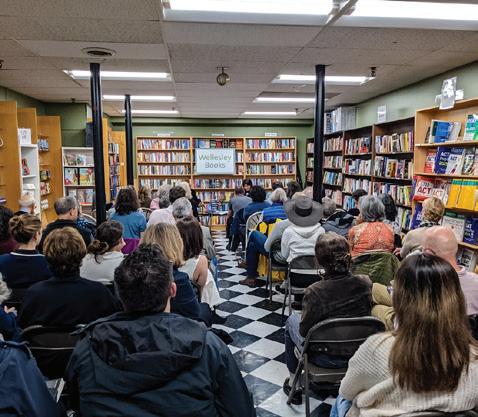
“this is a valuable moment for [him] and for Jessica [Liebowitz] to build on our experiences to create new pathways for innovation and reform in higher education, and [he resigns] knowing that the university will be in good hands.”
Liebowitz continued on, reminiscing about his time at the University and his years of leadership, specifically small group lunches that he hosted with his wife Jessica. Closing his email, Liebowitz stated, “The university’s accomplishments are numerous and remarkable for such a relatively young university, and there is no reason to believe it will not find the right path in the coming years.” He wished the community success moving forward.
The press release sent by Julie Jette, Assistant Vice President of Communications, further highlighted some of the accomplishments of Liebowitz, stating that “Liebowitz led Brandeis admirably through the challenges of the COVID-19 pandemic. He also led a campus-wide planning effort that yielded ‘The Framework for the Future,’ a comprehensive set of recommendations rooted in Brandeis’ historical strengths, its unique place in higher education, and aspirations for the future.” Jette has informed The Justice that no interviews with Liebowitz can be conducted at this time.
As displayed by the 149 to 159 vote of no confidence in President Liebowitz, faculty members have mixed opinions regarding Liebowitz’s resignation. One of the most outspoken supporters of the vote of no confidence, Prof. John Plotz (ENG), spoke with The Justice in an email exchange on Sept. 28. Plotz stated, “In cracking down on the November 10th protests, President Liebowitz’s administration mistreated students and violated his own Free Speech and Free Expression policies.” Plotz then continued to speak about the events of November 2023, saying that “[a]lthough many other factors contributed to his fall, this year’s student distress and widely expressed faculty outrage owed its force and persistence to the palpable injustice of meeting speech with force, and his unwillingness to acknowledge the errors and the hubris of that day.”
In elaboration regarding his personal beliefs of how this situation should have been handled, Plotz stated, “The philosopher Hannah Arendt says the truth of an event can be
Sheri T. Joseph publishes debut novel, 'Edge of the Known World'.
By GRACE DOH

GRADUATE UNION
■ A new agreement with the University enables student workers to focus on their studies and research.
By LIN LIN HUTCHINSON JUSTICE EDITOR
Brandeis graduate students play an integral role as teaching assistants, researchers, and mentors, yet their experience is markedly different from that of undergraduates. While essential services like housing, meal plans and comprehensive health insurance are often considered in undergraduate tuition, graduate students frequently find themselves navigating a more challenging experience at Brandeis. Graduate students, despite their importance to the University's academic operations, lack the same support systems that are readily available to their undergraduate peers. Many graduate students have voiced concerns that these disparities stem from a noncompetitive union contract compared to comparable institutions. However, this sense of insecurity may be reduced with a new union contract.
On Sept. 23, Brandeis’ Service Employees International Union Local 509, which represents educators, part-time faculty, PhD student teaching assistants, and teaching fellows, announced on Instagram that it had reached a tentative contract agreement with the University. The news comes three months after the initial expiration date of the previous contract, which was June 30, 2024 and was later extended to Sept. 20.
According to the union’s Instagram, the newly agreed-upon contract includes a wage increase, expanded child care stipend, increased paid parental relief period and workload protections. Notably, it also guarantees contract protection for workers assigned to research groups. Previously, the 2021-2024 Collective Bargaining Agreement only covered graduate students working as teaching assistants or teaching fellows, leaving graduate researchers — who face similar housing, food and financial insecurities — without protections.
In Sept. 2023, graduate researchers publicized their intent to unionize, seeking to address these disparities. Their efforts to unionize started in 2020 but a plan wasn’t voted forward with the National Labor Relations Board until Sept. 2023. Graduate students unionized during the spring 2024 semester and now are part of SEIU Local 509. They joined alongside TAs and TFs during this year's bargaining sessions.
All union members are now guaranteed a minimum salary of $42,000, representing a significant improvement from the previous range of $21,000 to $36,000. Graduate workers who are parents will also receive a guaranteed $1,500 for childcare and an extended paid parental leave period, increasing from eight weeks to 12 weeks. Ac -
AMANDA CHEN
cording to the Massachusetts Institute of Technology’s Living Wage Calculator, to live in Middlesex County, one adult without children would need to make $53,957, after taxes. Although the new salary makes it more manageable to address financial burdens, it still remains below what MIT calculates as sufficient income to live in the Greater Boston area.
The bargaining unit also developed stronger language and guidelines regarding workload, particularly for lab workers who have been called in on weekends and holidays. According to Cat Rosch, a TA, History PhD candidate and union steward, individual workload and when a research assistant can be called in was previously left to the discretion of the lab supervisor. Now, graduate research assistants can only be called in during holidays — such as Christmas, New Year's and other religious observances — if there's an urgent issue, like a critical experiment in jeopardy or malfunctioning equipment. There are now strict regulations on how soon after being called in during a holiday a worker must be compensated with a makeup holiday.
On Sept. 24, the union conducted two contract information sessions and between Sept. 25 and 26; all members were given the opportunity to participate in the ratification vote. According to Rosch, over 150 Members voted on the agreement and 98% of the members who casted a vote voted in favor of it.
“I'm really glad to see people who weren't part of the union before get union membership and get the protections,” Rosch said while reflecting on the negotiation process. She amplifies the continually expressed sentiment by graduate workers that workers aren’t able to spend adequate amounts of time on their independent research and dissertation when they have to work multiple jobs to make ends meet.
“I think it's really great that everybody got a pay raise and some of our programs were being paid less than $25,000 a year, which in the Boston area is frankly unacceptable,” Rosch stated.
The contract development and negotiation took nine months according to Rosch. The union began having meetings about contract negotiations starting in December, where they developed a dream contract. They didn’t begin meeting with the University until March, when they provided their original offer. Meeting once or twice a month since March, the union and the University negotiated back and forth providing counter offers. The part that took the longest was the economic proposal.
“It was really disappointing because it took the school about three months to even give us a financial proposal,” said Union Steward Rosch. “Their original financial proposal was, in my opinion, quite shocking. There was no pay equity in.”
The union has now approved and signed the contract. They are waiting for the University to sign the agreement for it to be formally accepted.
On Sept. 29, the Student Union Senate held its first official meeting of the school year. Vice President Ria Escamilla-Gil ’27 began the meeting. During the meeting, the senators heard from three clubs, voted on constitutional revisions, approved a mental health awareness event and voted for new positions within the Senate.
The first club to present at the Senate meeting was the HWAA Dance Crew. The Senate heard from Captain Kora Liu ’25, Co-Captain Emily Ren, Event Coordinator Angela Zhang ’25 and Event Coordinator Coco He ’26. The club started as a group of friends that would get together to choreograph dances for cultural shows and has since grown into a club. Its purpose is to create cultural diversity with a focus on East Asian pop culture and create a supportive community. According to their presentation, the club has already had a couple of meetings and is currently working on three separate projects. HWAA is composed of not only dancers but also photographers and editors. After a Senate vote, the club was granted probationary status.
The next club to present was the Badminton Club. The presentation was done by President Samantha Hinccliffe ’27, Secretary Anika Bhatia ’27 and Treasurer Maxwell Cowardin ’27. The club’s purpose is to be a fun, non-competitive and easy way to learn badminton, says the club. It is open to all students and no experience is required. Once they have the requisite equipment, the club plans on meeting once a week. After a Senate vote, the club was passed with probationary status.
The Senate also heard from the Fashion and Beauty Society,
The Justice did not recieve police report by press time.
about changing the club name to “Brandeis Fashion Society.” The club wants to change its name to bring in Brandeis and drop the word “Beauty” from their title. The club wants to focus on fashion, not beauty — which is a narrow word with associated stereotypes according to the club. Brandeis Fashion Society hopes to partner with fashion professionals at future events and make the club more interactive. The Senate approved them for the name change.
Student Union President Rani Balakrishna ’25 and Chief Judicial Officer Zachary Miller ’25 presented the amendments to the constitution, a process that began this last spring. Student Union members have been looking through the constitution and bylaws to update and revise them. Many changes have been made. Under Article Two’s revisions about executive board reports and updates, the mandates of when those are due are, as Balakrishna says, “more realistic.” Article Two Section Three revised the Student Union office hours to make it easier for members. The student body voted last year to remove the judicial branch, which is now just the Chief Judicial Officer. Article four has been revised to remove the attendance requirement of senators at Student Union meetings, and the requirements are less strict and more flexible. Balakrishna and Miller have also been working on a handbook for the student union board to make it easier to pass down through different administrations.
Another revision allows for proxy votes so senators can still vote if they cannot attend the meeting. Senators can now call for a vote on a proposal to get basic thoughts and ideas
of where other senators stand on proposals without the vote actually counting. The amendments also more clearly outline the impeachment process, the Senate meeting procedure, how committees function and update committee purposes and goals. The amendments passed in the Senate. The Student Union continues to work through and update its bylaws and constitution.
Senators Ava Ferrigno ’27 and Allie Lanham ’26 proposed hosting a mental health awareness table on Oct. 10, Global Mental Health Day. They plan to stock the table with mental health awareness stickers, fidget toys and talk about mental health resources students have access to. The proposal was expedited and passed.
During the meeting, the Senate voted for Sree Dharmaraj ’27 as their Allocation Board Representative. In her speech, she talked about her passion for ensuring that every voice on campus could be heard and emphasized the importance of communication. As allocation board representative, she will ensure better communication between the Senate, the A-board and the student body.
The Senate also voted for Daniel Shin ’27 as the Elections Executive Senator. Shin discussed his past experiences on committees, including the health and wellness on last year’s senate and his past experience as an Allocation Board Representative.

■ A news article incorrectly referred to Professor Emerita Bernadette Brooten as a Professor Emeritus. It was corrected to “Professor Emerita” (September 24, Page 1)
■ A news article incorrectly stated “Lenowitz also confirmed that conversations among the board are ongoing, explaining that the board is meeting on Sept. 23 and 24, and the vote of no confidence is one of their pre-scheduled meetings. It was corrected to “ The board is meeting on Sept. 23 and 24, and this is one of their pre-scheduled meetings for the academic year.” (September 24, Page 1)
■ A news article misstated “...the Second Intifada, an uprising against the Israel occupation, by Palestinians.” It has since be changed to state “...a Palestinian uprising after the failure of the Camp David summit in 2000.” (September 24, Page 2)
The Justice welcomes submissions for errors that warrant correction or clarification. Send an email to editor@thejustice.org.
■ While there are no WNV or eastern equine encephalitis cases in Waltham, public health officials urge residents to learn how to avoid mosquito bites and mosquito-proof their homes.
By AMANDA CHEN JUSTICE EDITOR
On Sept. 19, the City of Waltham posted on their news page that State Health Officials have found a mosquito infected with West Nile virus in Waltham. The mosquito was found in the Northeast Quadrant of Waltham and tested positive on Sept. 11.
According to the Massachusetts Department of Public Health, mosquitos have been testing positive for WNV and Eastern Equine Encephalitis since July, but the first human case of WNV and animal case of EEE occurred on Aug. 6. The first human case of EEE this season was reported on Aug. 16. The MDPH releases WNV and EEE risk maps based on seasonal testing from June to October. The tracker shows the number of positive mosquito samples as well as both human and animal cases for WNV and EEE. Data on mosquitoes that tested positive for WNV or EEE include the collection date, county, town and mosquito species. For information on patients who test positive for WNV or EEE, onset date, county of exposure, age, gender/ sex of the patient and clinical presentation are included in the dashboard.
As of Sept. 27, there are a total of 13 human cases of WNV and four human cases of EEE in Massachusetts. Currently, there are no WNV or EEE cases in Waltham. According to the MDPH there were six human cases of WNV in 2023. Comparatively, there were 12 human cases of EEE statewide in 2019 with six deaths, and five human cases with one death in 2020. There were no human cases of EEE in Massachusetts in 2021, 2022 or 2023. Each town is assigned a risk level for WNV and EEE. The scale for WNV risk level goes
from low to moderate to high to critical. For EEE, a five point scale is used: remote, low, moderate, high and critical. Waltham’s risk level for WNV is moderate, meaning that infection with WNV is likely or has already occurred. Waltham’s EEE risk level is remote, meaning that EEE is not usually found in the area.
According to Brian Farless, superintendent of the East Middlesex Mosquito Control Project and the Suffolk County Mosquito Control Project, in a Sept. 27 email to The Justice, each mosquito control district in the state submits samples and data to the MDPH, who then tests the mosquitoes for EEE and WNV. As the MDPH receives data, they update the WNV and EEE risk maps, daily case data and notify towns.
A full-time entomologist on staff for the EMMCP runs the mosquito surveillance program. The program uses three kinds of mosquito traps, says Farless. One trap targets mammal biting mosquitoes, and this type catches the species that spread EEE. The second trap targets the mosquito species that is the main transmitter for West Nile virus. The third trap is an Aedes oviposit trap and is used to look for the presence of the Aedes albopictus mosquito. Appearing in Massachusetts in 2009, this new species has been gradually moving throughout the East Middlesex district. It is currently not a primary vector for disease but could become a future concern.
Established in 1945, the EMMCP is a state agency “that conducts science based mosquito control for the good of public health” and practices “Integrated Pest Management ..., which means that we focus on source reduction[,] … mosquito larvae management, adult mosquito management, mosquito surveillance[,] … and education,” Farless wrote. The program also aims to fulfill its goals with the least negative impact on people, other animals and the environment. The Project services 26 participating communities, including Waltham.
The state is experiencing a recent outbreak of WNV and EEE because of the weather, explained Waltham’s Director of Public Health, Michelle Feeley, in a Sept. 27 inter -
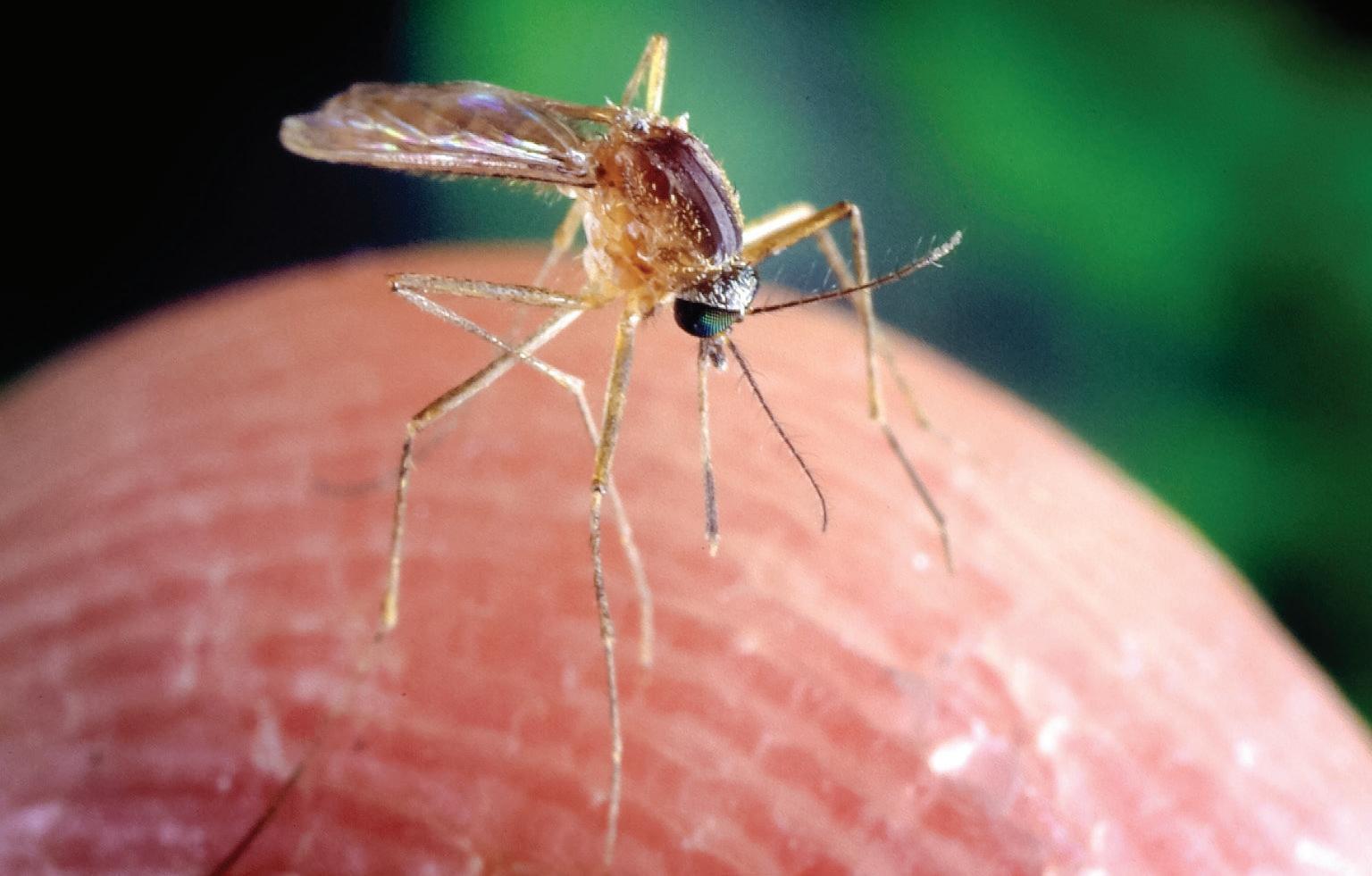
view with The Justice. While usually by this time temperatures should have dropped, they have remained high. Once the first frost comes, the Health Department expects cases to drop.
With climate change and rising temperatures, the incidence of mosquito-borne diseases can be affected. According to National Public Radio, the transmission process –– a mosquito biting an infected animal, living long enough for the virus to develop in them and transmitting it to a human –– depends on temperature since mosquitoes are cold-blooded animals. According to the Central Massachusetts Mosquito Control Project, mosquitoes thrive at 80 degrees Fahrenheit, become lethargic at 60 degrees Fahrenheit and cannot survive below 50 degrees Fahrenheit. However, climate is only one of the factors causing outbreaks, and EEE is hard to study because it is a rare disease.
For example, people’s proximity to infected birds and mosquitoes matters. For WNV and EEE, the virus is transmitted from infected mosquitoes to humans. Humans cannot spread the disease to each other, nor can mosquitos bite infected humans and become infected. Humans are dead-end hosts because they cannot spread the virus to mosquitoes.
The Centers for Disease Control and Prevention states that WNV “is rarely transmitted from person-to-person by blood transfusion, organ transplantation, and mother to baby, during pregnancy, delivery, or breastfeeding.” There are no vaccines to prevent these two diseases, nor medicines to treat them.
For WNV, eight out of 10 people with the disease do not develop any symptoms. Additionally, around one in five people develop febrile illness from WNV, and symptoms include headaches, body aches, joint pains, vomiting, diarrhea or rash. Most people in this category recover completely, but fatigue can last for weeks or months. According to the CDC, approximately “one in 150 people who are infected develop a severe illness affecting the central nervous system such as encephalitis ... or meningitis...” The CDC also states that about one out of 10 people who develop a serious illness affecting the central nervous system die.
EEE is rare, but serious. Around 30% of people who develop severe eastern equine encephalitis die. Moreover, many survivors have lasting neurological problems. Most people with EEE do not develop symptoms. Similarly, patients with EEE can either have a febrile illness or a neurological disease. Most people recover completely after one to two weeks if there is no central nervous system involvement. Neurologic disease can include meningitis or encephalitis, and symptoms consist of fever, headache, vomiting, diarrhea, seizures, behavioral changes, drowsiness and coma.
Feeley stated that children, the elderly and people with compromised immune systems are particularly vulnerable populations for these two illnesses.
Public health officials urge individuals to take preventative measures to avoid mosquito bites and reduce mosquito populations. Wearing long clothes to cover their skin, as well as using insect repellent, can help reduce the chance of being bitten. They also recommend people to avoid being outside during active biting times for mosquitoes which is from dusk to dawn, install and repair screens and drain any standing water where mosquitoes can lay their eggs.
If bitten by a mosquito, Feeley recommended that people monitor their symptoms, note if they have been in an area at high risk of WNV or EEE and contact their physician with any concerns.
To lower mosquito bites, the EMMCP implements spraying operations to reduce mosquito populations. Farless wrote that “[m]ore spraying will be considered as disease is found. Spraying stops when mosquito activity drops, which is usually during September of each year. Due to increased EEE risk during 2024, more spraying was conducted, but, as of late September, spraying has concluded for the season.”
The decision to spray depends on whether there is a high number of mosquitoes in the traps and if disease is found. According to Farless’ email, there are two spraying methods: truck-mounted Ultra Low Volume spray and backpack mist blower. The truck travels and sprays areas from sunset until around 11:30 p.m. to target peak mosquito activity time and avoid pollinators. Sprayed 20 feet into the air and floating up to 300 feet laterally, the ultra-fine mist kills mosquitoes on contact. When the pesticide lands, the product breaks down rapidly, leaving little to no residual and is no longer effective at controlling mosquitoes.
The second method consists of an employee on foot with a motorized backpack mist blower spraying the perimeter of an area. This product leaves a residue, and similarly, this activity happens at night to avoid pollinators.
Each pesticide is authorized by the Massachusetts Pesticide Board, and the board only approves pesticides that have been previously approved by the Environmental Protection Agency.
When asked about how the program measures success in reducing mosquito populations, Farless responded that “[s]ince mosquitoes are everywhere in very large numbers, … there is no way of knowing the total population of mosquitoes in a city/town at any given time.” However, he stated that their control methods –– source reduction, ditch maintenance, larval control and adult control –– have been proven to shrink mosquito populations.
One challenge for the EMMCP has been filling seasonal positions. From mid-May to mid-August, an employee usually would walk or bike through cities and towns in the district and place packets of larvicide into catch basins. The main mosquito species for WNV is found in catch basin water.
Since there are no WNV or EEE cases in Waltham, Waltham’s public health department is mainly monitoring the situation and sharing guidance with citizens through social media. “It’s on our radar but we’re not actively pursuing anything for it … We’re very aware of it, but the most we can do is tell people the guidelines as of right now,” Feeley stated.
To people who are worried about mosquito-borne illnesses, Feeley encourages residents to reach out and learn how to protect themselves. If Waltham’s risk levels for WNV or EEE rise, stricter policies would be issued. Feeley hopes that as October approaches and subsequently temperatures drop, the likelihood of more positive cases will decrease.
share program may be coming to Brandeis next year
■ One Brandeis student’s passion for a bike friendly campus leads to action.
By LIN LIN HUTCHINSON JUSTICE EDITOR
More than 15 years ago, Brandeis University had a bike share program that provided students with day-long bike rental services. Prof. Emerita Laura Goldin (ENVS) started DeisBikes in 2009 with students from her “Greening the Campus and Community” class. The program stopped about 10 years ago, but one Brandeis student is looking to revive it.
Allan Feldman ’26, a bike enthusiast, has been riding his bike to and from school since middle school. He has continued this habit since coming to Brandeis, especially last year when he lived in the Charles River Apartments and “didn’t want to rely on the shuttle.” Though the apartments are considered on-campus housing, they sit outside of all campus facilities, separated by the commuter rail train tracks.
According to Feldman, riding a bike on campus was not easy. He quickly realized it was difficult to find bike racks on campus.
Comparable universities like Tufts University and Worcester Polytechnic Institute have student-led bike share programs that were founded in 2011 and 2017 respectively. Feldman hopes to implement a similar program at Brandeis.
“I noticed there was a lack of accessibility for commuters,” Feldman said in a Sept. 27 interview with The Justice. “My first goal was simply to increase the bike accessibility
on campus, to encourage a more bike culture on campus”
In this pursuit, Feldman learned about DeisBikes through speaking with staff of the Brandeis Library, the Department of Student Affairs and the Department of Public Safety. The program, which was student led, operated and maintained a fleet of more than 60 bikes out of the Shapiro Campus Center. According to Feldman, the share program dissolved because of a “lack of a longevity plan” and because there was a reliance on volunteers to conduct bike repairs. After DeisBikes’ founders graduated, there was no one available to maintain the bikes, and ultimately they were “left to rot,” Feldman said.
“I learned there was actually a presence of a bike share and I thought ‘why can’t I just revive this’ because it seemed to align with my goal of creative accessibility for commuters on campus,” he said, retelling the moment he wanted to expand the project beyond getting more bike racks on campus.
Feldman is looking to have a collection of 28 bikes, bike locks and helmets available for students to rent. He shares that during the program’s infant stage rentals will be limited to 24 hours —with no distance restriction — but eventually will offer semester-long rentals.
To avoid a downfall similar to the one faced by the DeisBikes organizers, Feldman expressed the importance of being in discussion with the Brandeis Library, the Office of Student Affairs, Public Safety and the campus operations department. He anticipates bikes to be housed in proximity to the library, where the bikes can be checked in and out, similar to the process for how books, laptops and umbrellas are able to be checked out. The library is also a “more student central” location according to Feldman, making it a more consistent and reliable space for the
program to be housed.
“A big part of the SCC is that we’re not going to know how that is going to change,” Feldman said, reasoning why the SCC was a failed location for DeisBikes. “Whereas in the library, we know things will stay the same.”
As for repairs and supplying of the bikes, Feldman shared that there is discussion of working with local bike shops that will provide full tune-ups each semester and any additional repairs throughout the year. Additionally, a long term bike share student team would be formed and trained to understand the software needed to track bikes should they be checked out beyond the rental time. Currently, it is unclear how the program will be funded or how much it will cost.
In 2009, the Student Union unanimously passed a $1,305 grant to assist with the startup costs of DeisBikes. However, to start a program like this can be very expensive. For example, Tufts Bikes was able to receive a
$50,000 grant from the university for the program. This initiative comes during a time where the University is cutting back on staffing and departments. When asked if the University would be willing to financially support the programs, Feldman remained optimistic.
“I would imagine that, if they cared about making a sustainable environmentally friendly campus, this should be one of their priorities,” Feldman expressed, emphasizing Brandeis’ close proximity to bike friendly cities like Somerville and Cambridge. “The benefits of the program outweighs the cost, because the impact of the program like this would create a transformation in the University that I think would serve for decades to come.”
An interest form has been circulating around the student body for the last couple of weeks, but the program would not be in full swing until the 2025-26 academic year, Feldman said.
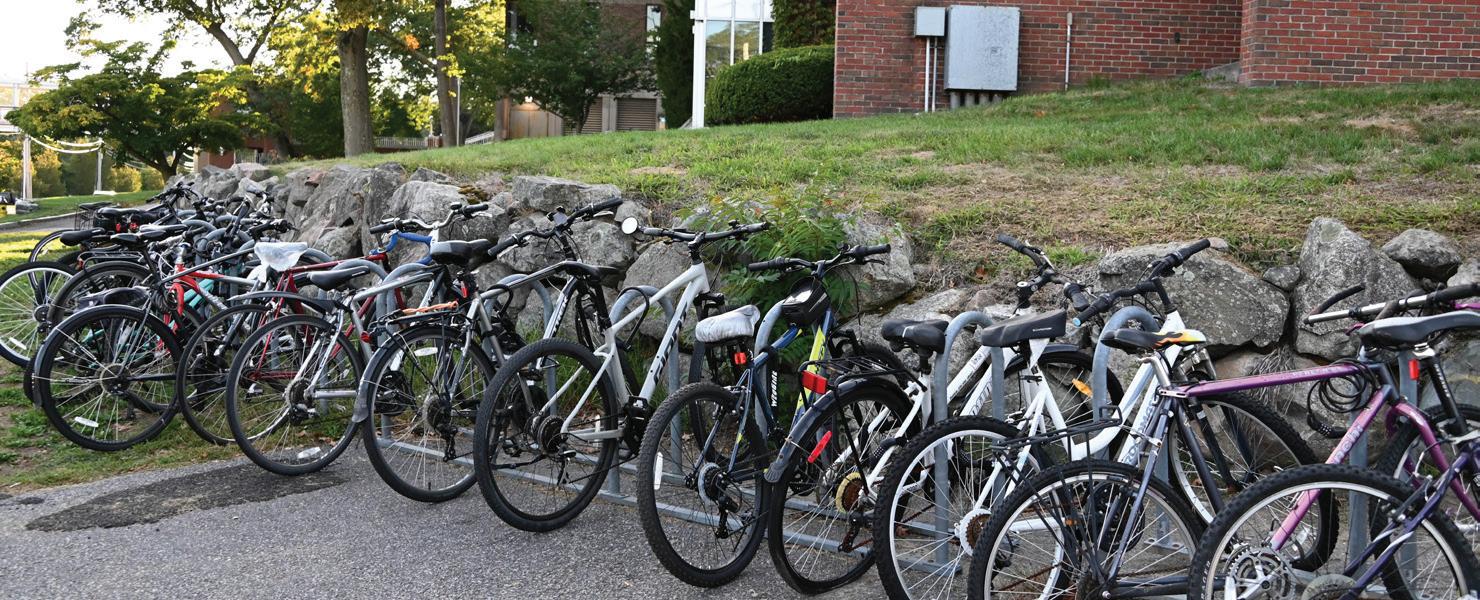

■ The concept of proxy weddings, in which the ceremony is conducted without the presence of one or both parties involved, has a place in ancient history.
By HANNAH SHAPIRO JUSTICE CONTRIBUTING WRITER
On Monday Sept. 23, Dr. Ramie Targoff delivered a lecture entitled “Proxy Weddings, from Shakespeare to Rubens,” in honor of her achievements as the Jehuda Reinharz Professor of the Humanities at Brandeis. Occurring in the Rapaporte Treasure Hall, the lecture was sponsored by the Office of the President.
The event began with comments from President Ronald Liebowitz, who expounded upon Targoff’s illustrious academic achievements, including the publication of several books such as “Shakespeare’s Sisters: How Women Wrote the Renaissance” and “Posthumous Love: Eros and the Afterlife in Renaissance England.”
Liebowitz was followed by English Department Chair Prof. John Burt (ENG), who elaborated upon Dr. Targoff’s impressive literary career. Regarding her book “Shakespeare’s Sisters,” he commented that “she has recovered these figures not only through her scholarship, but through stories,” a sentiment that would be demonstrated throughout the subsequent lecture.
Targoff delved into Peter Paul Rubens’ famous medieval cycle of paintings “Life of Mari de’ Medici,” focusing on the particular painting “Marriage of Maria de’ Medici and Henri
IV Per Proxy,” in which Mari’s proxy wedding ceremony with her uncle is depicted. The painting represents a quintessential example of the proxy wedding, the performance of a wedding ceremony without the presence of either the bride, groom, or both. In the case of this painting, the wedding was conducted before the bride and groom had even met. This practice was often employed among royalty, to facilitate marriages across distant kingdoms.
Targoff explored the concept of marriage by proxy throughout several time periods, including biblical, ancient, medieval and Shakespearean times in order to trace its evolution throughout history. Over the course of these time periods,the definition of marriage itself expanded from a legal agreement to a religious sacrament. She traced the shift from solely male proxies to brides being able to use proxies as well.
Targoff explored the rich emotional complexities of marriage by proxy through a close reading of Shakespeare’s ‘Much Ado About Nothing,’ commenting that the action often resulted in “the severing of a temporary but authentic bond.” She spoke of the phenomena in which the proxy developed genuine feelings that they were forced to suppress.
Audience member, Em Clemens ’28, reflected in an email interview later that night that “I’m in Professor Targoff’s ‘Shakespeare Now’ class, so when we were told she was being honored and giving a lecture I knew that I had to go. Before going to the talk, all I knew about marriage by proxy was what we discussed when reading ‘Much Ado About Nothing,’ which she touched on a bit, but I had no idea how interesting and prevalent it was.”
On Sept. 24, Dr. Targoff commented in an email correspon -
dance with The Justice over email that “The topic … raises important questions about human agency and when we can delegate our voice or our will to another person to represent us. This has repercussions in the religious, political, and social sphere.” When asked why she is so passionate about studying proxy weddings throughout history and literature, she responded “ I chose this topic to speak about because it reaches across the humanities. … [It] [includes] materials from the Hebrew Bible, Roman legal codes, Christian law and doctrine, as well as two plays from Shakespeare and multiple paintings by Rubens… I chose this topic in part because it reflects wide interdisciplinary thinking. I am also simply fascinated by its utter strangeness and complexity.” Dr. Targoff also explained that she found this topic pertinent since her newly endowed chair focuses on the humanities and much of career at Brandeis has been devoted to expanding the University’s interest in humanities.
Clemens further commented that, “In class, it is apparent that Targoff is very educated and passionate about her area of study, and it was wonderful to hear her lecture outside of class. I started reading her latest book ‘Shakespeare’s Sisters’ before I knew that she was going to be my professor, and now that I know her as both the author and the professor, I can say that her honoring is well deserved.”
The audience left Dr. Targoff’s lecture with a newfound understanding of the emotional complexity and rich history behind a painting that most people have encountered at some point in their academic careers. Following the lecture, President Leibowitz presented Dr. Targoff with an engraved chair, in honor of her newly awarded accolade.
■ O’Neil shares the creative and personal approach to her work, drawing from past experiences of social issues
By AURORA ZHAN JUSTICE CONTRIBUTING WRITER
The first poetry reading of the 2024 – 2025 academic year was held in Rapaporte Treasure Hall on Sept. 25 by poets Krysten Hill and January Gill O’Neil. The event was a celebration of O’Neil’s latest book, “Glitter Road.” The event began with a reading by Prof. Krysten Hill (ENG) of her previous and latest poetry, the creative approach and her reflection on identity, grief and education. O’Neil shared the creative inspiration behind her new book and read a few of the poems she is most proud of.
O’Neil’s previous works include “Rewilding” (2018), “Misery Islands” (2014) and “Underlife” (2009). She served as executive director of the Massachusetts Poetry Festival from 2012 to 2018, and her poetry appeared in The New York Times Magazine, American Poetry Review and the Academy of American Poets. O’Neil’s “Glitter Road” reflects her personal experiences in Oxford, Mississippi while pursuing the John and Renée Grisham Fellowship, intertwined with historical and social reflection.
During her talk, O’Neil spoke about watching the news, where she was shocked to learn that three white University of Mississippi students had been pictured standing with guns in front of a bullet hole-covered memorial sign dedicated to racial violence victim Emmitt Till. Till was an African American teenager who was abducted and murdered in Mississippi in 1955 after being accused of whistling at a white woman. This experience led O’Neil to think deeply about whose stories are remembered and whose are forgotten. “Glitter Road” weaves together the legacy of Till with O’Neil’s own reflections on
race, family and belonging, prompting readers to confront difficult truths about the past and present.
During the event, O’Neil read one of her poems, “Hoodie,” which centers on her son. The poem was driven by the killing of Tamir Rice, a 12-year-old African American boy, who was shot by a white police officer while playing with a toy gun in Cleveland, Ohio. O’Neil shared her thoughts regarding how her personal experiences as a mother and writer influence her work, explaining that all of her books include poems about her children, weaving in the complexities of raising children in America.
After sharing emotional reflections on race and history in Mississippi, the poet promised that the following readings would “get a little lighter.” O’Neil described Mississippi as a place that both surprises and meets expectations. Despite social challenges, she emphasized the beauty of Mississippi, a state with natural scenery. Her next poem was “The River Remembers,” which reflects that natural beauty and her time in the state from 2019 to May 2020. She recounted the experience of traveling along the Mississippi River: “I think I have a thing for rivers,” she mused, describing the river as a witness of the past and the present — a place where “flow and marvel and history converge.”
O’Neil closed the reading with two poems: “Black Women,” as “a tribute to the many black women who inspired” her in the creative process, and “What’s Love Got to Do With It,” a poem inspired by a Tina Turner song that shares the same name. The former is dedicated to the Black women who have broken through silence and prejudice and inspired the world. The latter, however, isn’t just about Turner’s song, but about a moment in the music video that stayed with O’Neil for years. She described how, in the video, Turner casually flips her hair — a small gesture that stayed with the poet because of the confidence it showed, capturing the natural charm of “a woman fully in command of her power, flaws and all.”
When asked about writing on personal and sensitive sub -
jects, O’Neil encouraged fellow writers to be unafraid of exploring controversial or intimate topics. She reminded the audience that while writing in safe spaces like classrooms is important, sharing work publicly can provoke unexpected responses, both positive and negative. However, she emphasized the necessity of “be[ing] aware of what might come back to you, whether it’s something personal like family matters, or it’s something that might be a little more controversial.”
O’Neil and Hill also discussed the topic of exploring traumatic experiences in writing. O’Neil talked about her experience conducting research while writing in Mississippi. She would often “sit down right after going to an event and write,” then step away for a while to distance herself from the memory, take a break and make notes, allowing her to return to writing later. At the same time, when she was doing research, she would not write, aiming to keep the two tasks separate, as “it will feel like when you’re peeking in on two people having an argument.” However, she described that conducting research would often spark new ideas and reflections for her writing. Hill also mentioned that the theme of trauma is very complex and exploring it requires authors to give themselves time.
“It’s kind of like digesting, right?” Hill said. “That has a whole science to it.” She also suggested that when writing about broad topics like racial trauma, if a creator doesn’t know where to start but feels compelled to write, they can begin with something small. “Focus on one thing,” she advised. “You can’t put everything in one room.”
As the event concluded, it became clear that “Glitter Road” is not just a book of poems — it is a journey through personal and collective history, with the goal for readers to reflect on how the past continues to shape the present. Concluding the event, O’Neil hinted at future projects, noting that while she hasn’t yet written much about her home state of Virginia, she is exploring its historical legacies and may incorporate these themes into her next work.

On Sept. 24, the U.S. News and World Report released its “Best National Colleges” ranking for 2025, revealing that Brandeis has dropped another three spots from its ranking of 60 in 2024. Now, the University finds itself tied at 63 with George Washington University, Michigan State University, Pennsylvania State University’s University Park campus, Santa Clara University, Tulane University and the University of Miami.
This change reflects Brandeis’ drastic shift in the U.S. News and World Report’s 2024 ranking from last year, where it notably fell 16 spots — from 44 to 60. After the University learned of this loss, President Ronald Liebowitz addressed the matter in a Sept. 18, 2023 email. He pointed to “significant changes in methodology” that then “removed or decreased the weighting of indicators that were favorable to private institutions.” These changes include reducing the importance of faculty salaries, reducing the value of financial resources per student and eliminating metrics related to “class size, faculty with a terminal degree, alumni giving and high school standing.” Liebowitz also mentioned a change in the report’s consideration of “expected graduation rates” instead of true graduation rates,
which he claimed to favor larger institutions, for example.
Following the release of this year’s ranking, Liebowitz has not addressed the community as of press time.
The U.S. News and World Report explains that due to fewer methodology changes to create the 2025 ranking, “117 of these schools stayed exactly in place in this edition, compared to just 80 the year before.” The majority of institutions saw minor changes. In fact, the institutions in the middle of the list were more likely to face more significant annual changes because their data is similar to each other. Institutions at the higher or lower ends of the list are outliers, since their data is not similar to other schools.
The U.S. News and World Report added that within the institutions with changed rankings in 2024, “neither public nor private schools were advantaged, as evidenced by the net changes in rank among all schools in subgroups being close to [zero].” Instead, the institution said that the most impactful change in methodology was “the removal of six-year bachelor’s graduation rates of first-generation students as a ranking factor,” or more specifically, “the rate at which a cohort of students graduate in the six-year period after enrollment.” The team
replaced this factor with putting more emphasis on Pell Grant student graduation. That being said, this change had a “minimal” impact for “the majority of schools.” Brandeis has also fallen on the U.S. News and World Report’s “Best Undergraduate Teaching—National Universities” list, falling from 48 in 2024 to 70 in 2025. Now, the University is tied with several institutions, including but not limited to Columbia University, Auburn University, Clark Atlanta University, Florida International University, Grand Valley State University and Seattle University. Despite dropping ranks on the National University rankings and in its “Best Undergraduate Teaching” lists, the U.S. News and World Report has given the University a notable upward trend on its ”Best Values Schools” list, putting Brandeis at 31. This ranking is eight spots higher than its 2024 position, and 10 spots higher than its ranking from 2023.
■ The Journalism department hosted the top New York Times lawyer, who spoke on important issues facing the press today.
By ISAAC BIRKENTAL JUSTICE CONTRIBUTING WRITER
On Friday, Sept. 27 at 9 a.m., approximately 100 students, alumni and faculty of Brandeis University flocked to the Spingold Theater. David McCraw, Deputy General Counsel and Senior Vice President of The New York Times, took the stage to tackle big issues in contemporary media and politics. The event was moderated by a duo of Brandeis journalism professors: Prof. Neil Swidey (JOUR) and Prof. Ann Silvio (JOUR).
The moderators opened by painting a detailed picture of McCraw’s accomplishments. Swidey said he “play[s] a pivotal role” in journalism and various First Amendment issues, in addition to being the point-man for securing the return of kidnapped journalists abroad. The room was relaxed and friendly, and McCraw
spoke freely on various journalistic and political issues. For example, he was adamant about the importance of our populace remaining in touch with the news to be informed voters. He said journalism is experiencing a “trust crisis,” and encouraged people not employed by the media to speak up about the importance of trustworthy, independent journalism.
Similarly, McCraw called for a “toning down of the rhetoric attacking the press.” He expressed significant concern with former President Donald Trump’s rampage against the media, and noted that McCraw’s staff receives many threats against their lives as a result of the now heated political climate. He also touched on topics such as how The Times vets questionable sources, balances public interest with complying with legal obligations and the importance of governmental non-interference in journalism. As McCraw is a lawyer and a journalist, he said he is obligated not to advance crimes. He specifically honed in on the gray area of reviewing and publishing information obtained from leaks, citing both the 2013 Edward Snowden fiasco and the recent hacks targeting both the Trump and Harris campaigns.
Edward Snowden was a former National Security Agency and Central Intelligence Agency contractor and employee, who dis-
covered that the United States was engaging in mass warrantless surveillance against its own citizens. Disillusioned, he became a whistleblower, securely exported top secret documents evidencing his claims and gave them to journalists. More recently, Iran targeted the Trump campaign and leaked the results of opposition research conducted on his vice presidential shortlist, including JD Vance. McCraw acknowledged that publishing leaked information encourages further hacking and leaking, but was clear that if information is relevant to the public it may be published regardless.
The event concluded with McCraw taking questions from the audience, addressing each inquiry with care and concern. One audience member asked how the news and people who are told to avoid it to protect their mental health can reach each other. He acknowledged the difficulty and complexity of the modern relationship with the press, but doubled down on the necessity of having an informed populace. Finally, McCraw left the audience with his assurance that speaking to students restores faith in humanity, and encouraged people to spend the time to do so.


CONTINUED FROM 1
buried temporarily - but we should never despair because things do come back to light and to life someday. Liebowitz mistakenly believed that his stonewalling and gaslighting of the faculty meant that November 10’s real meaning could stay hidden.” He followed up this statement by saying, “I think we should take some comfort from the fact that a President who responds to peaceful protest with violence may pay the price eventually. Ten months is a long time - but not too long to wait for that lesson.”
While differing opinions are present regarding the handling of the student protest on Nov. 10, many agree that it, as well as the terrorist attacks of Oct. 7, has played a part in the resignation of the president. When contacted by The Justice on Sept. 27, Prof. Jonathan Sarna (NEJS) shared a statement that he had written for the Jewish Telegraphic Insider. Sarna wrote, “When the history of how American universities respond to Oct. 7 is written, I think presidents who spoke up courageously on Israel’s behalf and they acted upon his conviction … And really as a result of that, Brandeis today is known as a safe haven for Jews, Israelis and for their advocates.”
Sarna went on to discuss this resignation as a part of a bigger picture, stating “Ron, along with his wife, Jessica, gave their all to Brandeis during an extremely tumultuous era. His resignation, like so many presidential resignations this year, tells us more about higher education and the challenges it faces than about the presidents who resigned.”
Prof. Avital Rodal (BIOL) explained her hopes for the future of Brandeis in an email exchange with The Justice on Sept. 27, as she has previously expressed concerns about the potential fallout of the vote. In her statement, Rodal expressed, “I hope the new leadership can continue to tackle our structural issues and work closely with faculty as we evolve to meet
the challenges and opportunities of the coming decades while staying true to our strengths and values. I don't think this recent leadership transition speaks to any change in those strengths or values. I also hope our alumni can see this, and continue to actively engage with all the amazing research and learning we’re doing, and help to support our shared mission.”
In the University’s press release, it was detailed that “The Board, Interim President Levine, and academic and administrative leaders will collaborate closely to ensure that students, faculty, and staff continue to be supported in their important work.” This sentiment of continuing initiatives was echoed in the email from Kranc, as it stated, “I assure you that the Board will collaborate with [Liebowitz], with Provost Fierke, and with the Faculty and administration to ensure that this transition is a smooth one for our community. We will continue to move forward with key initiatives, including planning for Brandeis’ newest residence hall, enhancing student life, and convening the Presidential Task Force on Free Expression.”
The Justice spoke with Student Union President Rani Balakrishna ’25 on Sept. 26 to gain her perspective regarding how this change could disrupt student life. When asked about the upcoming transition period, Balakrishna stated, “We will continue to work closely with Student Affairs, Dean Shoulson, and the President’s office during this time, and to the best of my knowledge we will still be able to present to the President’s cabinet.” This statement was followed up with a question regarding the potential challenges as a result of this transition taking place mid-semester. In response, she explained, “I am not too concerned about the transition taking place in the middle of the semester as the rest of the administration are dedicated and truly care about the wellbeing of the student body. They continue to work hard
every day, and a lot of their work is behind the scenes support.”
When asked about the role Student Union will play in this transition, Balakrishna stated, “We will continue to represent the student voice to administrators and provide input when the search for a new president commences. I will be meeting with the interim President, Arthur Levine ’70 as soon as possible, and I aim to be on the search committee as well.” She elaborated by saying, “I know that finances have stressed out many members of the Brandeis community, I hope that President Liebowitz’s successor is able to increase the entire campus’ budget to bring back programs that were cut.” Balakrishna expressed hope for the future of Brandeis, concluding with the statement, “I have always taken great pride in this position and I think that during this transition I hope to really lean into being a leader across all of campus so that students can still find the resources and support that they need.”
The Justice also connected with former Student Union President Peyton Gillespie ’25 on Sept. 27 regarding his experience working with Liebowitz throughout his term. He began his statement by acknowledging that the two reasons he believes resulted in this departure are “disputes regarding his handling of the antiIsrael protests on campus last year, and … the current financial state of the University.”
Gillespie explained that himself, as well as “many of [his] fellow Jewish students deeply appreciate President Liebowitz’s firm defense of the Jewish community since October 7th.” He told The Justice that he chose to attend Brandeis to get away from antisemitism that he has previously faced and to find a Jewish community.
Gillespie shared data from Hillel International, showing rising rates of antisemitism on college campuses over the past year. Gillespie stated, “Protesting the Israeli government is one thing,
but calling for violence against Jews or for the elimination of the State of Israel is hate speech, full stop, and I am proud that the administration took quick, decisive action to ensure the safety of Jewish students at Brandeis and send a clear message that hate has no place on our campus.”
He went on to praise Liebowitz for his actions, as well as delve into the concept of financial responsibilities. Gillespie acknowledged that the community is all aware of Brandeis’ financial challenges to some extent, and stated, “In my mind, whether or not President Liebowitz’s responsibilities include the financial management of the University, I have a hard time believing that others aren’t also responsible for the issues — such as the Board of Trustees, or the University’s financial management office, whom I think could be more open about their own responsibility in the issue.” He called for all players involved to be held accountable, not just Liebowitz.
Gillespie concluded his statement to The Justice with a message of support for the soon to be former president. “I deeply appreciate President Liebowitz’s service to the Brandeis community and am thankful to have had the opportunity to work alongside him while I was Student Body President,” Gillespie said. “I hope that our next president has the same strong commitment to protecting and standing up for Jewish students and continuing to develop Brandeis as a leader in undergraduate education in the US rooted in Jewish values."
The departure of Liebowitz has been met with a mix of emotions from the Brandeis community, some being sad to see him go while others expressing excitement for a new beginning. Administration and Student Union seem hopeful for a smooth transition as the campus gets ready to welcome interim President Levine.
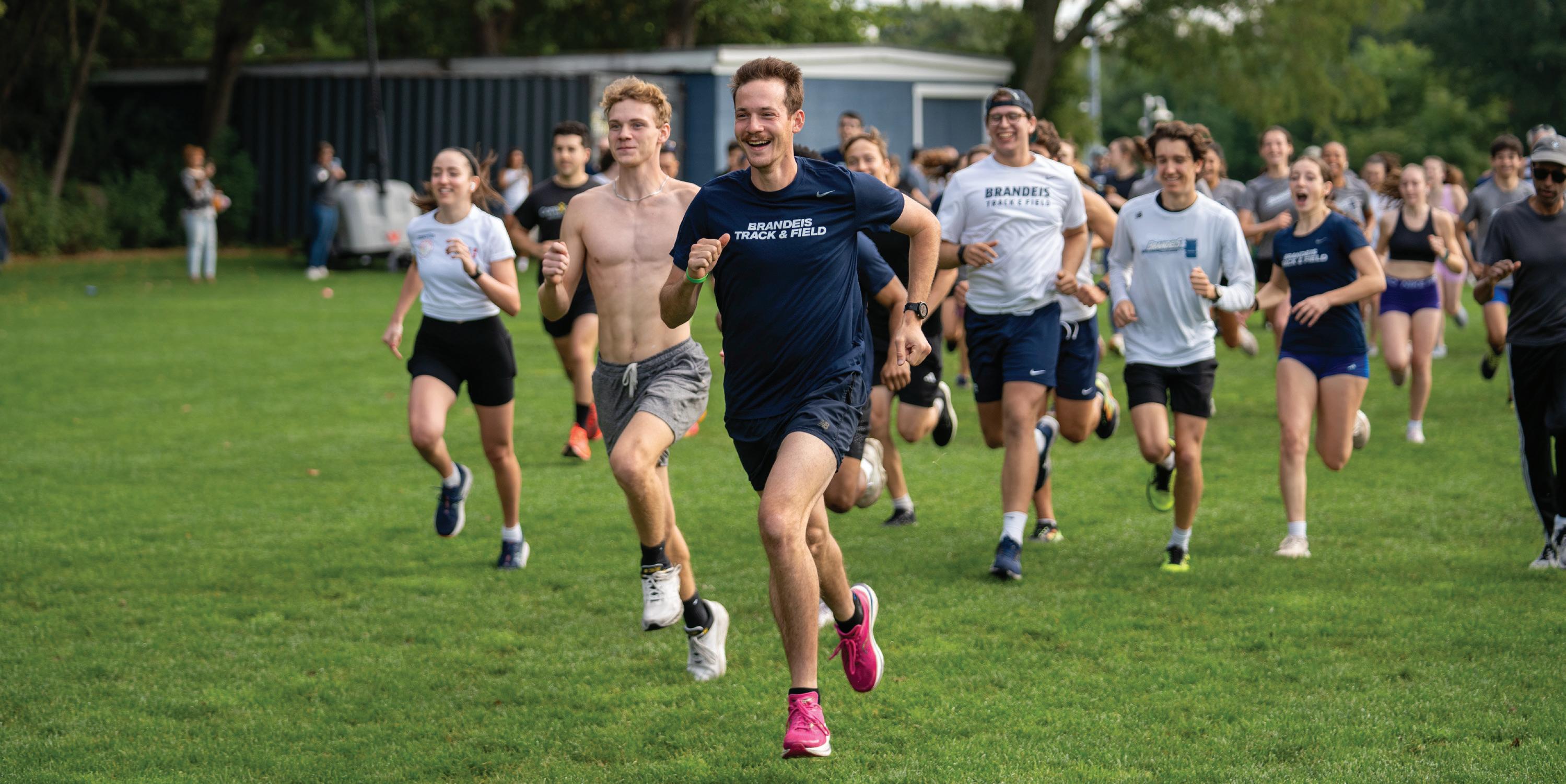

We tell ourselves stories in order to survive.
ON THIS DAY…
Yosemite National Park was established in 1980. FUN FACT
If unwound and linked together, your DNA could stretch from the Earth to the sun and back about 600 times.
Sheri T. Joseph’s debut novel explores the harrowing possibilities of genetic testing and surveillance in a near-future dystopia. In this story about love, adventure and family secrets, Joseph raises pressing questions about privacy, identity and the power of government over our most personal information.
By GRACE DOH JUSTICE EDITOR
In an era where services like Ancestry.com and 23andMe make genetic testing as easy as mailing a saliva sample to a lab, what are the implications of these technologies in the context of political surveillance? This was the question that author Sheri T. Joseph had in mind after attending a lecture that discussed Adolf Hitler’s attempts to develop a blood test that would detect Jewish and Romani children who appeared Aryan. Through the story of Alexandra Tashen, a refugee looking to find her father across nations while risking being caught at every security checkpoint, Joseph explores the potential consequences of DNA technologies on genetic privacy in her debut novel, “Edge of the Known World.”
On Wednesday, Sept. 27, Joseph discussed her novel at a Wellesley Books author event, moderated by her sister Prof. Susan Birren (NEUR/BIOL), Head of the Division of Science at Brandeis. The event attracted over 50 attendees, including Brandeis students, faculty and local community members. What followed was an insightful conversation about the novel’s themes and real-world connections, from genre-busting to abuses of genetic screening technology.
“Edge of the Known World” is a near-future love and adventure story about a young woman who Joseph terms a “refusé” or “a person refused permission to emigrate from their land of origin, who upon fleeing to avoid persecution or danger is refused entry or sanctuary by other lands.” Joseph’s novel imagines a world where a simple cheek swab at the Department of Motor Vehicles or airport could reveal your genetic makeup, making it impossible to hide, regardless of how you look or the documents you possess. While the premise might sound like science fiction, Joseph and Birren emphasized that the nov-
el’s dystopia is not far removed from current realities. The author pointed to China’s ongoing use of genetic testing kits similar to 23andMe to build a database of Uyghur and Kazakh minorities. This database, Joseph explained, is used for government surveillance to limit travel and control minority populations.
“None of this is far-fetched or abstract anymore,” Joseph said in a Sept. 19 interview with Birren and The Justice. “They’re using genetic screener tests to make sure people don’t travel, to monitor who you are when you apply for a government job — basically to keep people contained.”
This kind of surveillance is no longer the stuff of fiction. Just last year, a hack into 23andMe exposed millions of account profiles of Jewish and Chinese customers, whose genetic information was sold on the dark web. Joseph credited Birren with foreseeing some of the consequences of genetic testing kits nearly 15 years ago when she began conceptualizing systems that resemble what is happening today.
Despite the novel’s dystopian elements, Birren was quick to clarify that “Edge of the Known World” is not just a book about science. “This is a book about people, families and the seismic shifts in the geopolitical maps of the world,” Birren told The Justice. “It’s about the impact on individuals and families who are just trying to live their lives.”
However, the novel’s basis in science is undeniable. Tashen’s status as a refugee is complicated by a genetic marker — residual genetic material from a vaccine administered only in the Sovietlike regime that Tashen was born in. This tiny marker makes her vulnerable to exposure during genetic screening. Joseph explained that Tashen’s father, a scientist, developed a type of gene therapy to try to camouflage the

marker, but the treatment is only partially successful. Every time she undergoes a genetic screen, there’s a one-in-ten chance she will be caught.
Birren expanded on the novel’s scientific themes by discussing how genetic privacy laws in the United States lag behind technological developments. While there are protections in place, such as laws preventing insurance companies from using genetic information to deny health insurance, many other areas remain vulnerable. “The regulation always lags behind the speed of the science,” Birren noted, “there are all these situations where, probably when the law was passed, people weren’t thinking about it.”
Joseph’s novel speculates about a potential future where governments — rather than just private companies, use genetic databases for more sinister purposes. But the reality, Birren pointed out, is that we are already living in a world where genetic information can be used for purposes other than health and ancestry. From denying life insurance policies to screening for government jobs, the potential for abuse is vast.
Furthermore, “Edge of the Known World” is also a story about love and adventure. Tashen’s journey is one of rebellion. After learning she is an illegal refugee smuggled into the U.S. as an infant, she spends her life avoiding genetic screens. When her father disappears, she sets out to find him, defying all the restrictions that have kept her safe. Along the way, she gets involved in a love triangle that complicates her journey.
“It’s really an adventure story, galloping from peril to peril,” Joseph explained. “But it’s also a multifaceted love story. It’s about romantic love, but it’s also about the love between adoptive brothers and the love between a father

and daughter.”
This familial love is not just central to the novel’s characters but also reflects Joseph’s own upbringing. The author shared how her family’s intellectual curiosity and broad-ranging interests influenced the themes of the book.
“A lot of this goes back to the family we were raised in,” she said. “Our father was big on ethics, our mother was an artist, and we had these broad conversations about everything from art to the future of society.”
A recurring theme throughout Joseph’s discussion was the complex ethics surrounding genetic privacy. While genetic databases can be used to solve crimes or provide valuable health insights, they can also be exploited for nefarious purposes. Joseph referenced the British Broadcasting Corporation’s six episode podcast series The Gift, which explores how millions of people have contributed to an enormous global DNA database by doing online genetic testing kits without fully understanding the implications. Joseph’s primary concern, however, is the potential for governmental abuse. “The real focus

for me is the potential for governmental abuse,” she said. “The values we have in the United States around privacy are very different from other countries. Watching how different countries are using these technologies is instructive, and we should all be paying attention.”
Birren offered a more optimistic perspective on the potential for good that these technologies can do for society. “Just because that’s a possible future outcome doesn’t mean it’s written in stone,” she noted. “There are governments and people thinking about the ethics of all of this, and it doesn’t have to go in a negative direction. Gene therapies are already being used to treat diseases like sickle cell anemia and childhood neuromuscular diseases.”
Ultimately, Joseph hopes that “Edge of the Known World” will spark readers’ curiosity, encouraging them to explore the real-life issues the story is rooted in. “You need fiction to hit the heart, but you also need factual basis to hit the brain,” she said. “My goal is that this book cues people’s curiosity about genetic privacy, surveillance and refugee situations, enough that they’ll go and pull up nonfiction to understand the realworld implications.”
In combining heart-pounding adventure with thought-provoking questions about genetic privacy and the future of surveillance, Joseph’s debut novel dares readers to consider the ethical questions raised by emerging technologies. As we grapple with the consequences of our own DNA being digitized and stored, “Edge of the Known World” serves as a reminder that these issues are not far off in the future — they are happening now.
The universe of The P.A.’s is filled with orcs, golems and goblins.
By GRACE DOH JUSTICE EDITOR
As the singer and guitarist of the Lowell, Massachusetts based band The P.A.’s, Ellis Roundy’s role within the group exists at the intersection of music, storytelling and graphic design. With a distinct focus on world-building that is largely grounded in Jewish, Tolkien-esque and other mythologies, Roundy and his bandmates — Joe Milia (drums), Ian Miller (synth and keys) and Liam Asselin (bass) — have weaved a continuous narrative throughout their last few projects.
In a Sept. 29 interview with The Justice, Roundy shared insights into the band’s creative process and the inspirations that drive the artistry behind their “dungeon psych” sound. Sonically, The P.A.’s have been compared to garage and psychedelic acts like Ty Segall, Thee Oh Sees and King Gizzard and the Lizard Wizard, but they view their music as more than just a collection of songs — it’s a holistic experience that follows a continuous and thoughtfully crafted story arc. Roundy emphasized that their creative journey begins with establishing what events will unfold with their characters in the lyrics. “We develop sort of the outline for what the lore is going to cover on each record before we start writing,” he explained. This commitment to storytelling allows for flexibility during the recording process. Roundy noted, “If something just doesn’t come across the right way, I can just change the lyric and it’s fine. It doesn’t change the meaning of the song really, because I know what the meaning is supposed to be.”
This adaptability makes it so that the lyrics maintain alignment with the overarching narrative, as the group remains committed to coherence in both meaning and sound. “There’s a greater purpose than just the music and how things sound to us,” Roundy said.
While Roundy’s interest in Jewish and other kinds of folklore is integral to the project’s aesthetic identity, The P.A.’s’ songwriting process is highly collaborative. Roundy described a dynamic with his bandmates where all members contribute ideas during rehearsals. “A lot of the time, we’ll be like, ‘Okay, today we want to do a lot of writing,’ so everyone kind of comes with an idea prepared,” he noted. This collaborative structure can manifest in various forms, and can also fluctuate depending on the day and the inspiration that strikes the band.
Sometimes Roundy will present fully formed songs, while at other times the band develops ideas collectively. “We’ll flesh it out together,” he added. “Joe will come to rehearsal with an idea for a drum part, and then we’ll turn that into part of a song.” Their back-and-forth process cre-
ates a rich, layered sound that, over the years, has expanded in range.
“It’s a bit of give and take,” Roundy explained, describing the process as an organic blend of individual contributions and group decisions. “Sometimes I’ll bring them completely written songs, and we’ll go from there. It is truly a collaborative writing experience.”
The P.A.’s are currently navigating changes within their lineup, as their former bassist left to pursue personal projects and their new bassist, Liam Asselin, has joined the group. Roundy spoke about maintaining their creative momentum, saying, “We’re getting him acclimated to the band and rehearsing with him, but also writing at the same time.”
Amid this transition, The P.A.’s are staying consistent with releasing new projects. “We have an EP that’s probably going to be released the Friday before Halloween,” Roundy said. Looking ahead, he mentioned plans for another record to be released sometime early next year.
The P.A.’s are also eyeing touring opportunities. “We’re looking at touring the South soon,” Roundy said. While they are still finalizing details, the group is continuing to play shows around the Boston and New England area. “If you look at our Spotify, you can see if we’re playing near you,” he noted.
Performing live has been an integral part of The P.A.’s’ journey, and Roundy recounted one fond tour highlight from a show held at an art gallery in Elgin, Illinois: “We got a circle pit going which is where people just run in a circle as fast as they can and it just spreads.” During this performance, Roundy had stacked his cabs — which are essentially speakers housed in wooden enclosures — secured them with a ratchet strap and climbed on top of them. “Watching the circle pit go as I was playing from on top of the cab was a really wild experience,” he recalled fondly.
Roundy’s artistic inclinations extend beyond music into his work as a graphic designer and illustrator. “Communication and world-building are kind of inherent to both of those things,” he explained, referencing diverse influences from Swiss design to 1970s airbrush fantasy art. “Every time you create something, you’re building a world, whether it’s a graphic design project or a song.”
With The P.A.’s, Roundy combines his talents, handling the graphic design work for album covers and promotional materials. “To be able to have a project where I can do all of the illustration and all of the design work, and write the music and record it, and write all the lore around it — it’s an ideal project for me,” he said. This multifaceted role allows him to immerse

himself in every aspect of the project, creating an original blend of audio and visual elements.
He points to bands like The White Stripes and Tame Impala who are known for taking control of their unique aesthetic choices. “When you get a White Stripes record, it doesn’t look like any of the other records because they’re following a very strict guideline about how they want their stuff presented,” Roundy noted. He believes that a band’s image should complement its musical output. “It creates its own sound,” he asserted, noting the interconnectedness of visuals and music.
Roundy’s storytelling is informed by various artists he personally engages with. “Concept albums are obviously a ma-
jor influence on me,” he stated, citing artists like Grimes, Xiu Xiu and Pink Floyd as inspirations. “They’ve informed what the scale of an artistic project can be.” The level of depth and complexity of these concept albums motivate Roundy to push the boundaries of his own ideas.
As The P.A.’s prepare for their upcoming releases and continue to refine their collaborative process, Roundy’s vision remains clear: to build a discography grounded in an expansive fictional world that is uniquely their own. While the group has plans to continue performing across the country, they are still playing shows in the Lowell area, with their next show scheduled for Oct. 18 at The Valley.

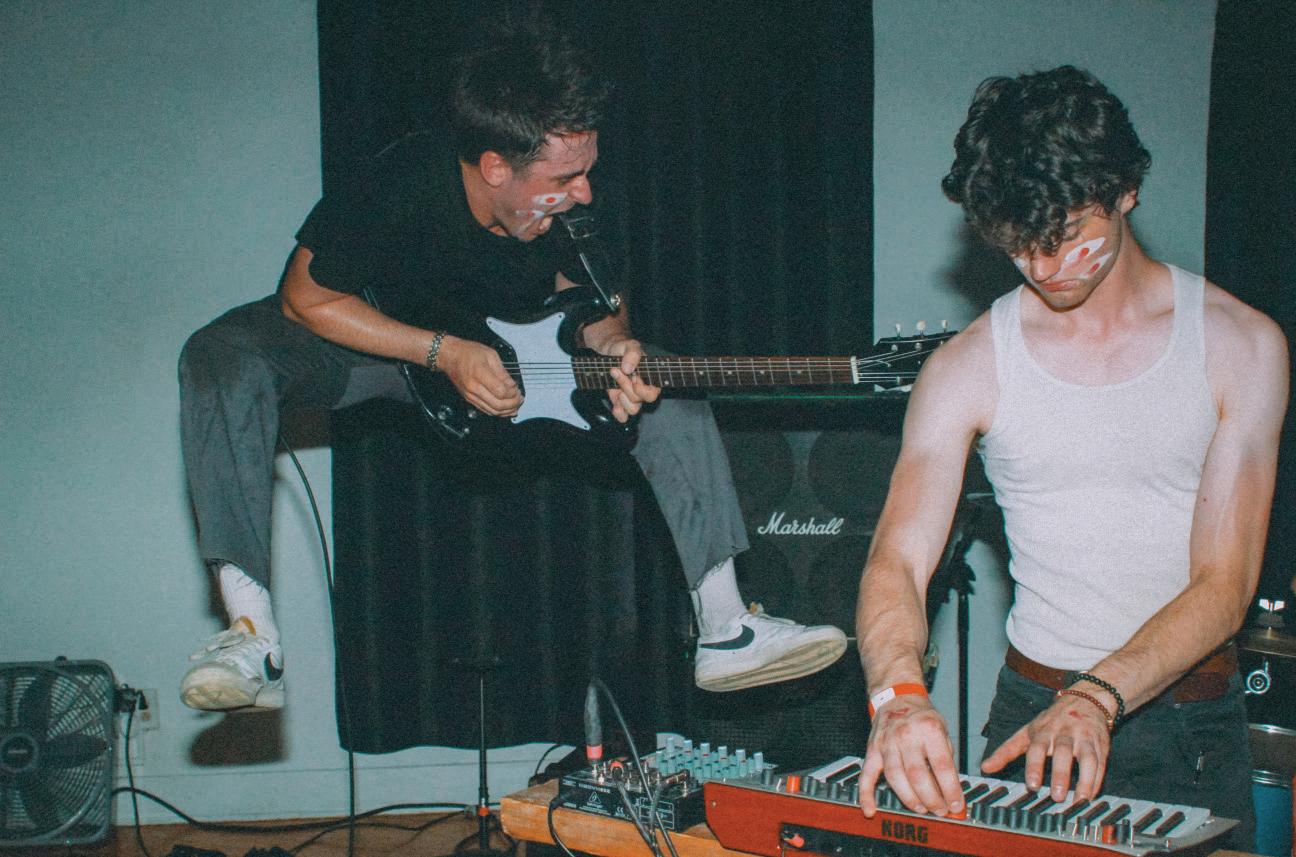

Established 1949
Anna Martin, Editor in Chief Eliza Bier, Managing Editor Isabel Roseth, Senior Editor
Leah Breakstone, Tibria Brown, Lauryn Williams, Deputy Editors
Owen Chan, Sophia De Lisi, Julia Hardy, Dalya Koller, Mina Rowland, Madison Sirois, Associate Editors
Lil Lin Hutchinson, Zoe Zachary, News Editors
Grace Doh, Features Editor
Nemma Kalra, Arts & Culture Editor
Jonas Kaplin, Bryan Wolfe, Photography Editors
Lily Chafe, Sara Samuel, Copy Editors
Marina Rosenthal, Layout Editor
Elizabeth Liu, Advertising Editor
Amanda Chen, Niámh Mullen, Social Media Editors
In the aftermath of President Ronald Liebowitz’s resignation, announced in an email on Sept. 26, the Brandeis community continues to adjust to the prospect of so much change at the University.
Given the speed at which this decision was announced, there continues to be disbelief throughout the Brandeis community. While the Brandeis faculty did vote in favor of passing a motion of no confidence on Sept. 24, no one thought the shift in leadership would come so soon.
Many satirical posts, memes and even celebrations flooded our social media feeds following the news of Liebowitz’s resignation. While we admit that it may be fun to take part in these jokes, we would also like to acknowledge that Liebowitz is a real person who has dedicated eight years of his life to serving the Brandeis community.
This past year has been a particularly difficult time for college campuses, and while this does not excuse the harmful actions that Liebowitz has taken, it is important to recognize the pressures that come with being a university president. Although it is easy to focus on the negatives, it is also unreasonable to blame Liebowitz for every problem that the University is currently facing. As such, we would like to take a moment to appreciate Liebowitz’s commitment to the University during his presidency. Leading a university is a daunting task with many moving parts and responsibilities, and eight years of such work cannot go unnoticed. It was under the leadership of Liebowitz that Brandeis secured the biggest single gift in its history for student financial aid, with Liebowitz also hiring the university’s first Chief Diversity Officer and Vice President for Diversity Equity and Inclusion. Additionally, we cannot forget how he successfully led the university through the challenges posed by the COVID-19 pandemic, ensuring campus safety through rigorous health measures.
With the news of Liebowitz’s departure, it is also important to recognize that this is a very serious moment for the Brandeis community. The future of the University now rests in our hands — and in the hands of whoever Liebowitz’s long-term replacement will be. We as a community must continue to work to make Brandeis the best institution possible. Although Liebowitz has certainly played a role in our budgetary crisis, and he has been responsible for decisions which have harmed students in the past, he is only one person amongst an entire administration. Many of Brandeis’ issues are deeply rooted in the structure of the University, and Liebowitz’s departure will not cause those issues to suddenly disappear.
When Liebowitz leaves on Nov. 1, we will be left with a relatively unchanged University
administration. We will also be left with all of the same problems that we faced under Liebowitz’s leadership. As such, there is a lot of hard work ahead — not just for whoever the new official president of the University will be, but for the Brandeis community as a whole.
As the search for Liebowitz’s replacement begins, Brandeis students, faculty and staff must continue to advocate for the changes we want to see. We must set our expectations high and ensure that these expectations are met. If we don’t, we will fall into the same cycle of empty promises and administrative inaction that have plagued the University for far too long.
Liebowitz’s departure has created the space for us to imagine what University leadership at Brandeis could and should look like. In our next president, we want someone who holds themselves accountable and takes responsibility for their actions. We want someone who works together with the administration, consistently talks with students and attends faculty meetings to ensure that all members of the University community are heard. We want someone who is consistently present on our campus — someone who does not hide behind locked doors or avoid appearances at campus events. Most of all, we want a president who is dedicated to open communication and true transparency with all members of the Brandeis community. In the past year, administration has consistently failed to keep faculty and students informed about important decisions that impact our community — such as the derecognition of Students for Justice in Palestine or the layoffs of approximately 60 staff. Given that the University is currently $2 million in debt, there is also a clear need for financial transparency. As individuals who pay so much in tuition dollars each year, students deserve to know how the University is using its money and how we found ourselves in this situation in the first place.
In the meantime, The Justice editorial board would like to extend a warm welcome to the University’s new interim president, Dr. Arthur E. Levine ’70. Amidst all this change, we hope to foster a strong relationship with you and work together to create a better Brandeis. While there is much room for growth, there is also a strong foundation in the form of passionate students, dedicated faculty and a resilient community. We hope that, as a Brandeis alumnus, you will share our commitment to the University’s founding values on a deeper level, and that with your help, we can work to make sure that Brandeis upholds those values in 2024 and beyond. We welcome you, Dr. Levine, to our school, and we hope this is a start to a new and improved Brandeis.
Thank you so much for reaching out! We’re excited to hear about your article on the new gender-affirming care services we’re providing at SSIS. This project has been in the works for nearly a year, and we’ve dedicated a lot of time to discussions and meetings to understand the needs of the Brandeis community, determine which products to offer, and identify the best avenues for funding. We conducted extensive research to find trusted brands that meet the needs of our community. After testing these products and gathering feedback on their effectiveness and accessibility, we’re proud to offer Spectrum Binders and TransTape. Transparency is important to us, and we want to acknowledge that the biggest challenge has been securing the necessary funding to make this initiative a reality. We couldn’t have done it without the generous contributions from GivingDeis
Day and donations through our link. We truly appreciate the ongoing support from our community and look forward to continuing to provide these life-changing resources. We’re also incredibly grateful for the support from the Brandeis Counseling Center (BCC) and the Brandeis Health Center, which have helped us learn about different types of gender-affirming care available at Brandeis. We recognize that our current selection may not fully meet the diverse needs of the Brandeis community, but we are actively exploring ways to expand our offerings. We currently have various genderaffirming products on our referral shelf; while we do not stock these items, we can help you find a reliable brand and place to buy them.
Best, SSIS
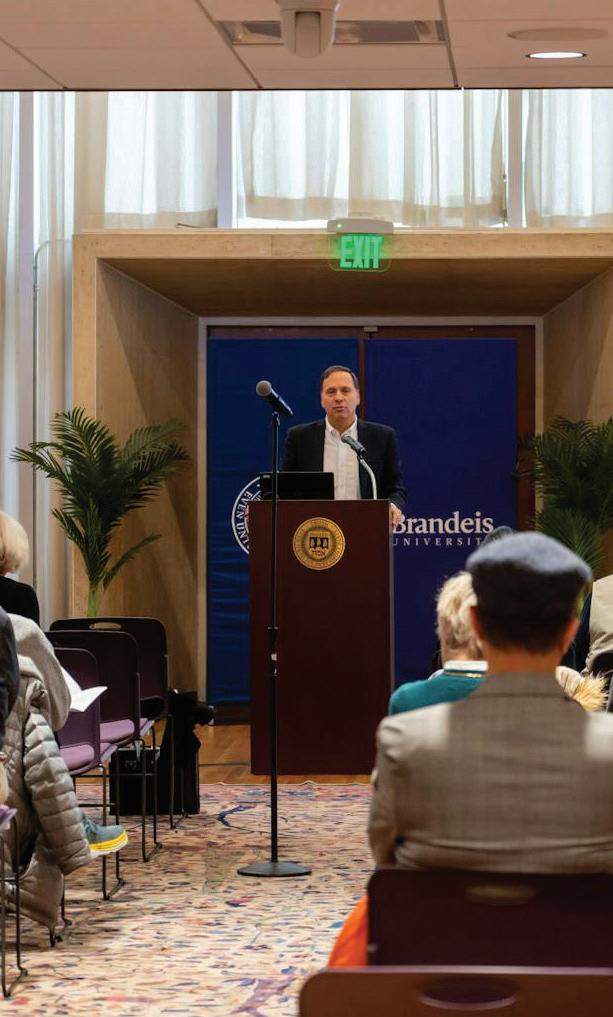

By GONNY NIR JUSTICE CONTRIBUTING WRITER
Researchers have explored the impact of news coverage of the civil rights movement and its influence on public and social opinion. A researcher from Princeton University’s political science department, Omar Wasow, suggested that the media covered civil rights protests in the 1960s in different ways, depending on whether protests were peaceful or violent. He argued that when protestors remained peaceful, particularly in the face of aggression and violence, the resulting images shocked a complacent nation into action. But when the protestors themselves turned violent, even in self-defense, the media message shifted from a framing around civil rights to one around the need for control.
Immediately following the catastrophes of the Second World War, a slew of academic articles, papers and reports were published on the “mass.” Intellectuals from American sociologist C. Wright Mills, to the political theorist Hannah Arendt and the gang of German exiles hanging around philosopher Max Horkheimer, wrote on the problem of the “mass,” or mass society. What does the “mass’ refer to, you may ask? The “mass” describes a group of people who have no sense for their individuality or what relates them to each other. In other words, a mass is a collectivity of strangers who are lonely amongst a crowd. These strangers are made twice estranged — both from themselves and from their peers. They hold no conception of self, meaning they can’t provide an answer to questions seeking to fill a conception of self with positive content. Furthermore, they can’t say what about themselves and their peers connects them to each other. They’re
atomized, and are therefore made blind to the commonalities that they share with their peers.
Why am I introducing this seeminglyarcane concept forged largely by highbrow, German intellectuals in tweed suits who despised the American “take-it-easy-baby” ethos? Because it maps onto the culture at this University.
What is “Brandeis culture?” I argue that it is the set of norms and practices which have led to the collapse of the distinction between the “who” and the “what” for students at this University. If you ask someone on this campus who they are, they will give you a response which details what they do. They will not have answered your question. The collapsing of this distinction is precisely why nearly everyone on this campus is depressed, overextended, unsatisfied or overmedicated.
Before we go any further, I can anticipate one of you good Marxists objecting with something like, “Aha! Yes, what you say is true and is indicative of the fact that the capitalistic ethos has crept into every institution in our social, political and economic lives.”
I’m willing to entertain this objection and even accept most of its claims, but I’m unwilling to accept that this culture is somehow preordained by the proletariat’s lack of ownership over the means of production.
Contrary to popular Brandeisian opinions, there are different ways of student-ing. We are just unwilling to accept them for reasons that I have trouble even calling reasons — because that would imply something resembling a justification supporting these purported explanations which is nowhere in sight. Capitalism can be blamed in part for this

culture, but you all — undergraduates — may not be responsible but are in fact culpable for upholding this culture.
Students here have an ideal in their heads of the “successful Brandeis student,” and we think that this student takes on three majors and three minors, leads multiple organizations on campus and takes five classes every term. Everyone has this image in their minds, and they think that if they are not realizing this ideal, then they are not “doing enough.” Somehow, we’re undeserving of success or praise if we’re not always embodying this ideal. Allow me to call this what it is: absurd. It is not “praiseworthy” to be overextended to the point that you’re not a reliable friend. You will not be “successful” in your professional life if you’re dissatisfied with your personal one.
The problem with this ideal is that in the race to realize it, we all become homogenized. Despite surface-level differences, we’re all fundamentally the same kind of person here. It is almost as if a degradation of personality has taken place on this campus: everyone is the same person at their core. And yet, students often admit to feeling lonely… it’s paradoxical, were it not for the fact that I’m explaining exactly what our dear German intellectuals understood as constituting a mass. None of us understand what it is that relates us to each other beyond being “Brandeis students,” which is not (or ought not to be) an identity, but an empirical fact. I had the privilege of studying abroad at a very different university last term, and I can assure you that students there did not think of themselves as students. That concept was reserved to describe what they did; it was not used to depict who they were. Hence, I ultimately reject the Marxist explanation for what is going on, on this campus because this does not have to be the way we go about college. Marxist theory requires a kind of scientific, historical necessity that the culture on this campus does not. We are all contributing to a culture that demands students to wipe away every semblance of individuality, and
for what exactly? Another line on your résumé? Another internship in which you do next to nothing and watch the clock tick every second of precious time away?
In the introduction to her magnum opus, German-American political theorist Hannah Arendt asks her readers to “think what we are doing.” I ask the same of you. Think about what it is you’re doing and why. Who exactly is telling you to take that internship which doesn’t compensate you for your time? Who is urging you to take on an unnecessary course that you don’t actually enjoy? Who told you that you need to be on another executive board? And who gave them the authority to tell you those things? Are those things adding to your life, and I mean in a much different way than by merely filling a gap in your Google Calendar, that reflects much more than the hours in a day?
The culture here is insufferable, and I hope we start awakening from the dogmatic slumber it has placed us in. I don’t intend to come off as patronizing in these remarks. I reject any comparison to the philosopher in Plato’s allegory of the cave who emerged from its deceptive shadows to find truth in the world. I haven’t found truth, but I have found some perspective (or so I’d like to think). I can assure you, being miserable without the time to do anything other than study, sleep, eat and black out to escape further studying is not a way to live. It is a way to exist, but we should expect to do much more than that — especially now. College is a unique time in our lives. You will never have this much independence with so little responsibility again — I promise. Why trade this opportunity to really live as you are in exchange for the burden of leading too many organizations, taking courses you don’t enjoy or doing internships in which you learn so little? We don’t have to do this. We don’t have to exist in this way. Disintegrating into a mass is not an inevitable consequence of coming to Brandeis; it is a choice we make and lifestyle we uphold. I ask us to demand more for and from ourselves.





■ A look into Australian driver, Daniel Ricciardo’s, career and departure from Formula 1.
By ELIZABETH LIU JUSTICE EDITOR
On Sept. 26, 2024 it was announced that Daniel Ricciardo would leave the RB Formula One Team immediately and would be replaced by Liam Lawson for the remainder of the season. Lawson previously stood in for Ricciardo when he suffered a broken hand after crashing during a practice in 2023. Lawson made his Formula 1 debut at Zandvoort, racing for RB for a total of five grand prix before Ricciardo returned. Ricciardo’s departure comes at a shaky time as there are only two unfilled seats left for the 2025 season and five current drivers without contracts. Although Ricciardo hasn’t officially announced his retirement, his inconsistent and low scoring performance this year makes his future in F1 uncertain.
Ricciardo, born in Australia in 1989, is known as the “Honey Badger” – fiercely competitive on the inside while always smiling and joking around in and out of the paddock. The Aussie also popularized the ‘Shoey’ in F1 after drinking champagne out of his shoe to celebrate his podium finishes. Prior to Ricciardo’s partnership with RB, he drove for Scuderia Toro Rosso, Renault, Alpha Tauri and McLaren. The Australian started off as a test driver for Red Bull in 2011, before being loaned out to replace HRT Formula 1 Team driver Narain Karthikeyan mid-season. During his F1 debut with HRT, Ricciardo did not score any points during the last 11 races of the season.
Ricciardo then signed with Toro Rosso alongside Jean-Éric Vergne for a completely new lineup in 2012. They both resigned for the 2013 season, with Ricciardo scoring 10 points in his first season with STR, and doubling it the next year while finishing a personal best of seventh place twice. His improvement in performance was reflected in the driver standings, as he jumped from 18th to 14th in the Driver’s Championship.
Impressed with his performance, Red Bull Racing Renault signed Ricciardo alongside the four time champion Sebastian Vettel. Learning from his experience at HRT and Toro Rosso, Ricciardo finished second in qualifying and second in the Australian Grand Prix, the first race of the season, before being disqualified due to a technical violation. After a "did not finish" result in the second grand prix, Ricciardo slowly inched up the standings, finishing fourth for the next two races and third for the following two before his maiden win at the Canadian Grand Prix. His impressive season only continued as he never finished outside the top ten – except for another retirement due to a broken car part – and won two more times consecutively at the Hungarian and Belgian Grands Prix for a total of eight podium finishes. Ricciardo’s admirable 2014 season with Red Bull landed him in third place in the Driver’s Championship, two places ahead of his teammate Vettel. His efforts also helped land Red Bull in second place in the Constructors Championship.
For the 2015 season, it was announced that Sebastian Vettel would leave the Red Bull team, with Daniil Kvyat taking his place. Red Bull debuted a new car for the 2015 season and Ricciardo struggled to maintain his output from the previous year. While consistently finishing in the top ten, the Aussie only had two podium finishes – neither of them a win. He fell to eighth in the Driver’s Championship, behind Kvyat, and Red Bull also dropped to fourth in the Constructors Championship.
The 2016 season saw child prodigy Max Verstappen join the Red Bull team alongside Ricciardo and a much more competitive car. Ricciardo was able to partially return to his former glory, only winning the Malaysian Grand Prix, but tying his eight time podium finish in 2014 and pocketing four fastest laps. During his podium finish at the Germany Grand Prix, Ricciardo debuted his “Shoey” celebration and repeated it after his win with Verstappen who also made the podium. Ricciardo’s improvement restored his third place finish in the Driver’s Championship, two places ahead of Verstappen, and another second place finish for Red Bull in the Constructors Championship.
Ricciardo’s 2017 season was similar to the previous one, scoring nine podiums and one win at the Azerbaijan Grand Prix. He never strayed below sixth place, but the impressive racing was dulled by sustaining six DNFs. The “Honey Badger” finished in fifth place in the Driver’s Championship, in front of Verstappen who finished sixth, both contributing to Red Bull’s third place constructors finish.
Ricciardo’s 2018 season saw two podiums – both first place finishes–in the Chinese and Monocan Grand Prix, eight DNFs but never finishing below sixth. This was the first time Ricciardo finished behind a teammate
while driving for Red Bull, as he ended in sixth and Verstappen in fourth in the driver standings. Both of their performances helped Red Bull’s consistent finish in third. In the middle of the 2018 season, the Aussie announced his shocking departure from his illustrious career at Red Bull to join the Renault F1 Team alongside new teammate Nico Hulkenberg for the 2019 season. In similar fashion to his time at Red Bull, Ricciardo suffered five DNFs and one disqualification, recording slower times throughout the season. He had no podiums in 2019 and only scored points in eight of the 21 races.
Although Ricciardo finished five places ahead of Hulkenberg, his ninth place Driver’s Championship standing was a disappointing end to the season.
Renault switched lineups after replacing Hulkenberg and pairing Ricciardo with Esteban Ocon. The Aussie’s only podiums in 2020 came at the Eifel and Emilia-Romagna Grands Prix, finishing in third on both occasions – a far cry from his only DNF to start the season. Consistently finishing within the points, Ricciardo improved his driver standings to fifth, seven places in front of Ocon, carrying Renault to a fifth place constructors finish.
After his two year stint at Renault, Ricciardo signed on to the McLaren Mercedes team to join Lando Norris after his previous teammate Carlos Sainz was contracted to join Scuderia Ferrari for the 2021 season. Ricciardo finished out of the points on nine occasions, but his only podium came with his only win of the season at the Italian Grand Prix. The McLaren drivers helped bring the team to a fourth place constructors finish, with Norris finishing in sixth and Ricciardo not far behind in eighth in the Driver’s Championship.
With the same lineup at McLaren for the 2022 season, both Norris and Ricciardo’s performances took a dip. The team finished in fifth place in the Constructors Championship, with Norris also finishing in fifth in the Driver’s Championship and Ricciardo six places behind in eleventh. Ricciardo had no podium finishes and only scored points in eight of the 22 races in another disappointing season.
McLaren Chief Executive Officer Zak Brown commented on Ricciardo’s performance, stating that he did not meet “his or our expectations, as far as what we were expecting.” Wanting a change and to return to his past success, Ricciardo left McLaren and went back to Red Bull, but this time as a reserve driver for the 2023 season.
Scuderia AlphaTauri, who shares the same owner as Red Bull, released one of their drivers Nyck de Vries in his rookie F1 season after he failed to score any points in the first ten races of the season. Red Bull lent out their third driver Ricciardo to replace de Vries, and he was set to start the 2023 season at the Hungarian Grand Prix alongside his new AlphaTauri teammate Yuki Tsunoda. Ricciardo didn’t fare much better than de Vries, only scoring once at the Mexican Grand Prix, finishing 17th in the driver’s standings. Tsunoda finished in 14th place, with AlphaTauri in eighth in the team rankings.
Renewing his contract with the team, now named RB Formula One Team, alongside Tsunoda, the pair improved slightly in the 2024 season. After the first 18 races of the year, Ricciardo sits in 14th and Tsunoda in 12th, but RB jumped to sixth place in the constructor’s standings. In an unsuccessful comeback, the “Honey Badger” has only scored in four of the 18 races, prompting the team to let Liam Lawson drive for the rest of the season instead. But in his last race this season at the Singapore Grand Prix, Ricciardo went out with a bang, earning the fastest lap and Driver of the Day.
Throughout his whole career, Ricciardo has always radiated positivity and laughter, and never let any racing drama affect his personality. He started his own line of merchandise named “ENCHENTÉ” that focused more on pure fashion than motorsports. Ricciardo’s perseverance through the tough seasons struck a chord with F1 fans, which was made even more apparent after becoming a fan favorite in Netflix’s “Formula 1: Drive to Survive” documentary, which gave a behind the scenes look into the F1 world. While many fans have expressed frustration regarding Red Bull’s handling of his exit, calling the announcement of his departure just days after his last race at the Singapore Grand Prix “cowardly and embarrassing,” there has also been an outpouring of love and support for Ricciardo on social media. Like Sky Sports commentator Ted Kravitz said: “Thank you to Daniel Ricciardo. Thank you for that smile, thank you for the shoeys … Thanks for the Enchenté merch … Thank you for being honest. Thank you for being a gentleman and thank you for being a proper great Aussie bloke Daniel Ricciardo.” Ricciardo has left a lasting impact on the sport, and his presence will be missed if the 2025 grid does not include the “Honey Badger.”
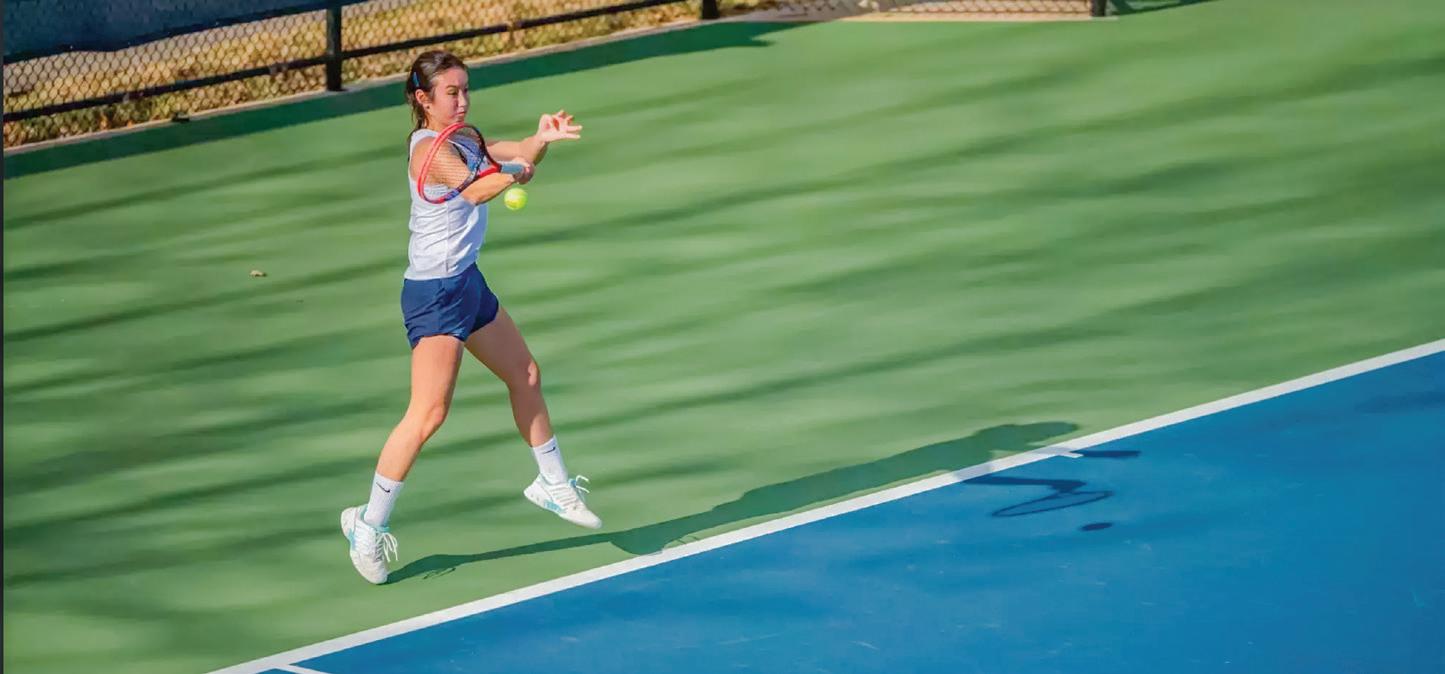
Reyes states, continuing her theme of embracing the difficult road to success.
“We don’t need the memories,” Mandy Reyes ’27 says. At first, this mantra might be hard for some to stomach, but to this sophomore on the Brandeis women’s tennis team, it means resisting the temptation to dwell on the past and instead finding optimism through always “reminding [herself] that it is a new day,” as Reyes explains.
In tennis, being optimistic also means reminding herself that there is always a new point to be won. Recently, Reyes has been on a winning streak — she captured the B-singles title at the 2024 Intercollegiate Tennis Association New England Regional Championships at Bowdoin College on Sept. 22 — but she understands that it takes knowing how to lose to understand how to win.
Reyes, who is from the Philippines, has been playing tennis for 11 years. She jokes that tennis has given her “an unhealthy desire to be the best that [she] can at everything that [she does].” Besides continuing her tennis career at Brandeis, Reyes has applied this positive attitude to academic and personal success. She shares that before she graduates she wishes to feel like she has “done something worthwhile — an achievement [or] accomplishment that would [make her] smile.”
At Brandeis, Reyes has also contributed to the campus community as a participant in DeisHacks, which is a “48 hour social good hackathon” that supports local small businesses in Waltham by inviting teams of students to “solve relevant non-profit challenges.”
As a first year, Reyes and her team won the 2024 Hackathon, and she cites this as her proudest accomplishment at Brandeis so far. Pointing to the 48 hours she spent working towards “making her project and pitch better,” Reyes says she will remember this accomplishment forever. “The stress was worthwhile,”
Reyes explains that she has tennis to thank for her grit. “Tennis taught me how to lose,” she admits. She reflects that the Swiss tennis legend, Roger Federer, “only won around 54% of the points he played and still won over 80% of his matches.” To Reyes, this shows that winning is not about having a perfect game statistically — instead winning comes down to fighting until the very end.
Reyes says that “to be beaten in a point, have a twenty-second break to reset and forget about it, and continue to play the next,” reflects the fact that tennis “is a brutal sport that forces a person to look past their earlier shortcomings and try for a better future.” For Reyes, a better future refers to not only the next minute of the game, the next set and the next match, but looking ahead as far into her career as she can imagine. Reyes is primed for a tennis career at Brandeis powered by impressive ambition and determination — and she recognizes the power of a team atmosphere in driving her forward as well. She says that “growing up playing an individual sport, [she] didn't know how it felt to be a part of a team. Up until university tennis, [she] didn't
can turn to and rely on.” Reyes and her fellow Judges will compete this coming weekend at the Bowdoin Invitational on Oct. 5. One can only expect that Reyes is looking forward to another “war,” as she puts it. Reyes says that she likes

The Bantams scored early in the 10th minute, but the Judges rallied, outshooting Trinity 17-5 before finally scoring in the second half. Senior Rachel Watler ’25 saved the day, leading the Judges to victory with a pair of goals late in the game just over three minutes apart, the first assisted by Peterly Leroy ’28.


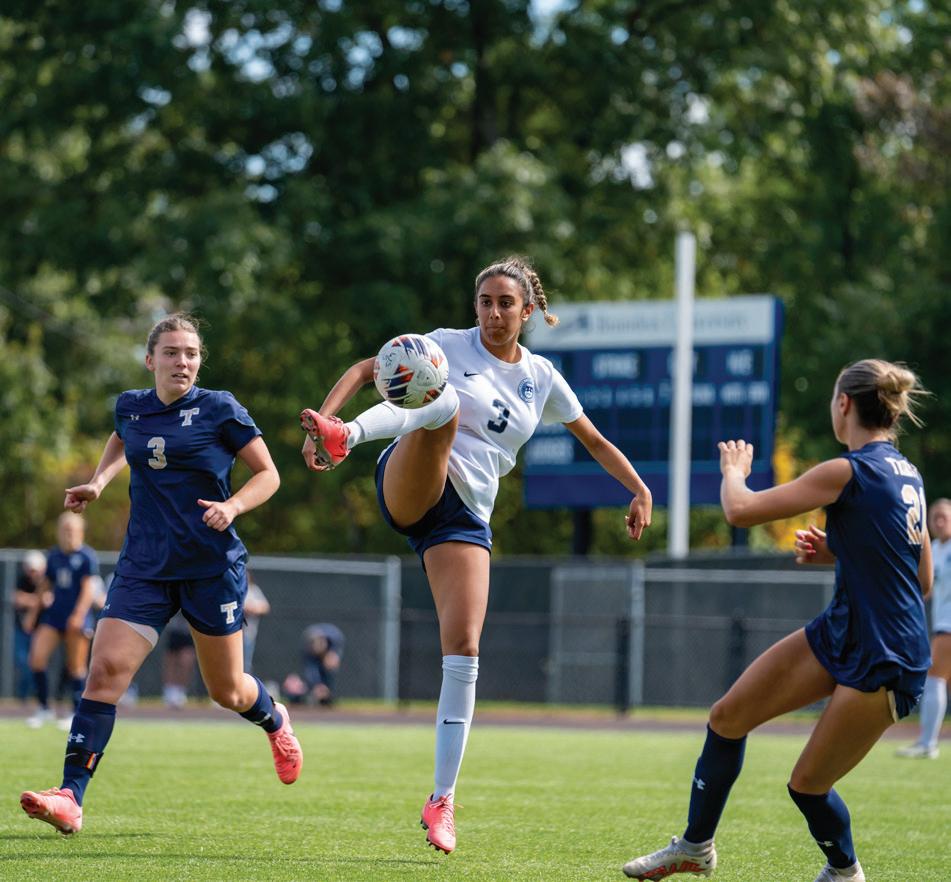
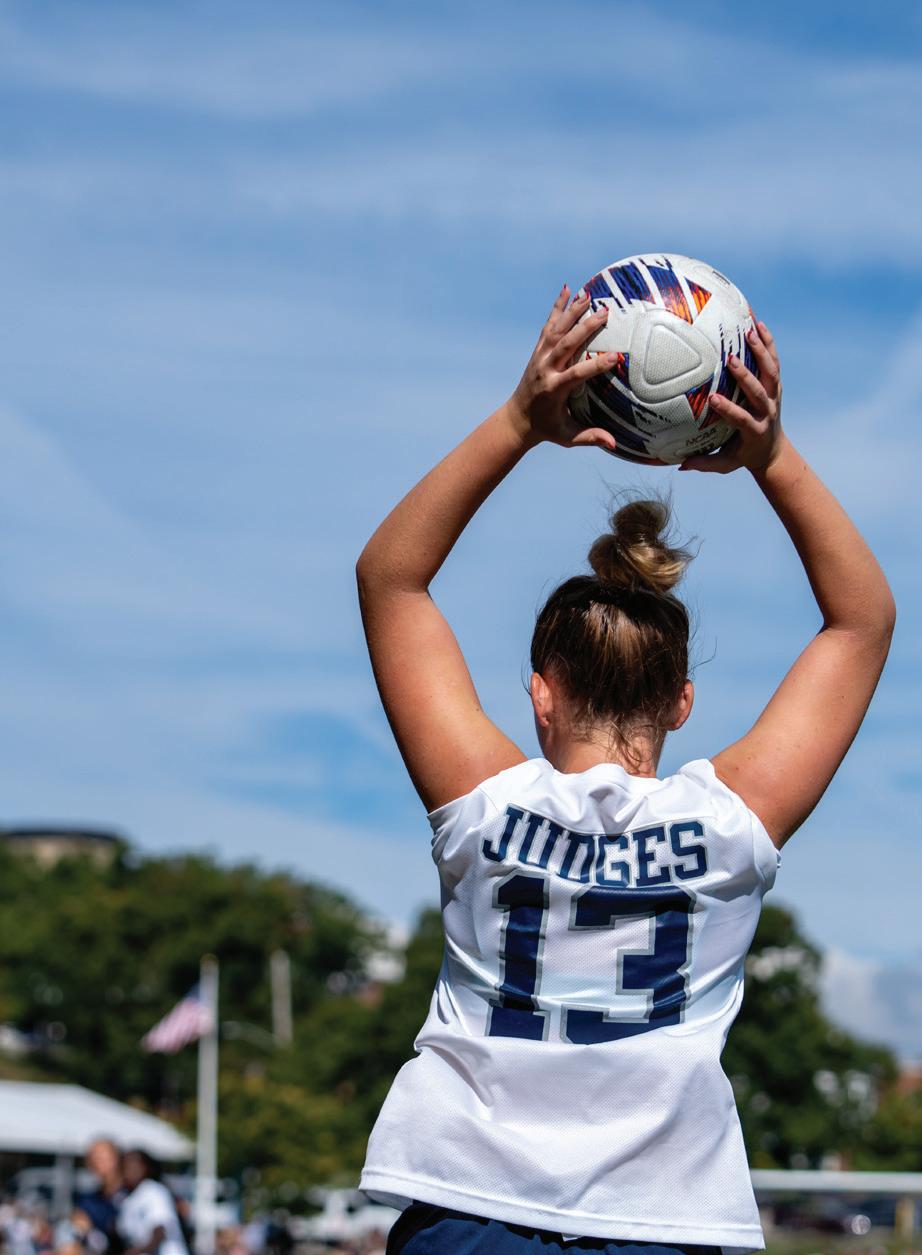

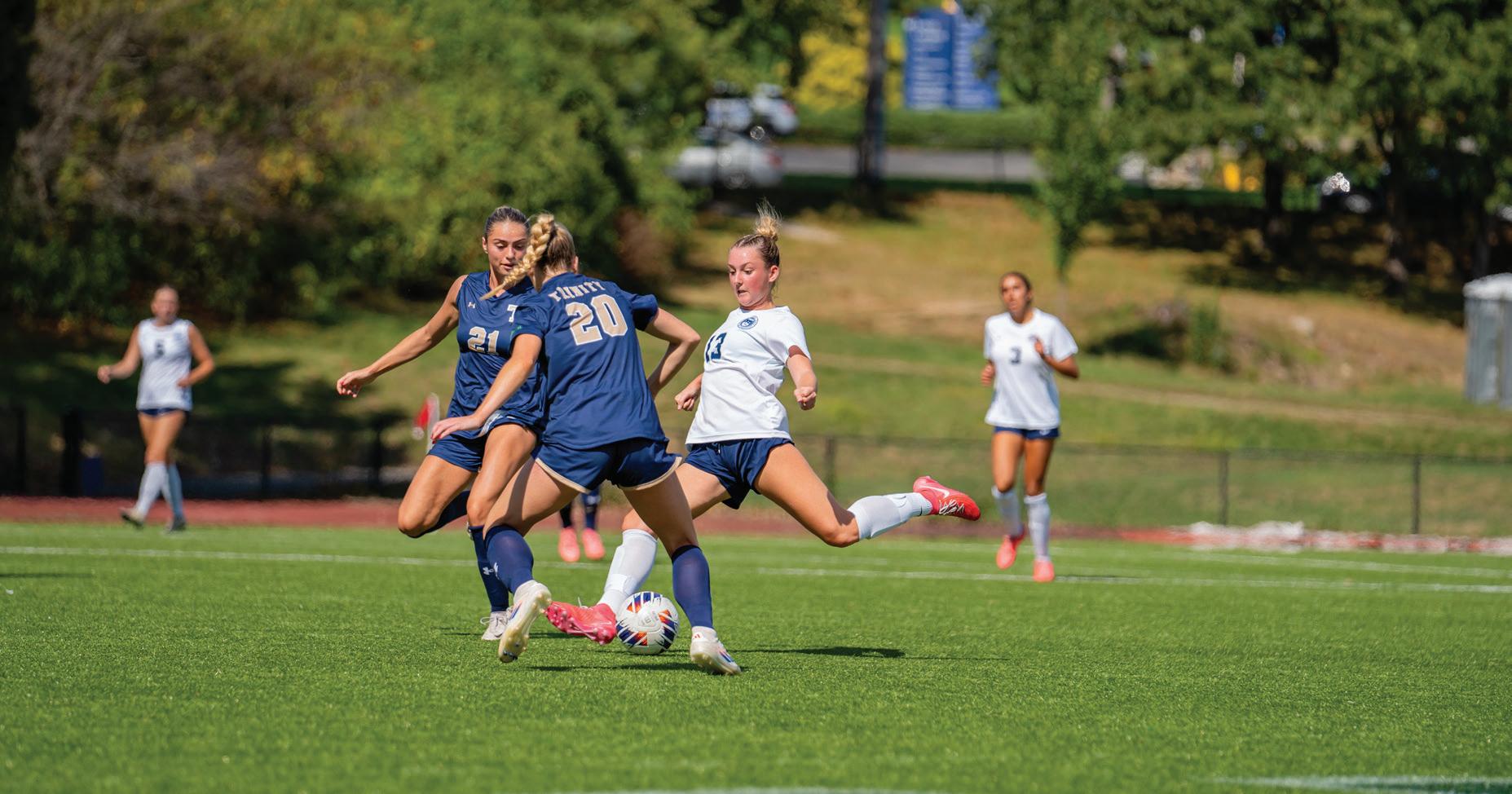


Bills’ defense did not look up to the task of stifling a deep Ravens offense, probably as a result of their ranks being filled with injuries. Quarterback Josh Allen was consistently bothered by the Ravens’ pass rush all night and despite his ingenuity and creativity outside of the pocket, he could not muster a successful comeback. On the other hand, the Ravens are making up for their slow start with some signature victories to showcase their status as contenders for the rest of the
season. Despite the shock and awe from these games, the NFL’s parity is at an all-time high, and there are many teams vying for future playoff berths and deep runs into the postseason. In fact, as press time, only two teams have yet to win a contest: the Jacksonville Jaguars and the Tennessee Titans. Furthermore, only three squads are still undefeated. This “leveling of the playing field” ensures that the NFL season will continue to be unpre-
dictable, but more importantly, entertaining. The joy of watching games where a winner is not predetermined is incomparable and it is essential to why we watch sports. Hopefully this trend continues in the future! Week 5

financial literacy for children in school and community groups in New York.”
By ELIZA BIER JUSTICE MANAGING EDITOR
This year Brandeis Athletics welcomed six alumni to the Brandeis Hall of Fame, ranging from the graduating class of 1974 to 2009. The sports represented were men’s track and field and cross country, women’s track and field and cross country, men’s soccer, women’s fencing, volleyball and the category of contributor.
The first alumnae inducted was Harold Small ’74. During his tenure at Brandeis, Small competed for the men’s track and field and cross country team. Small is a three time All-American in the 880-yard run and two-mile relay. Additionally, Small had a “thirdplace finish as a junior in the pre-Division III era, while helping the cross country team to 24-straight tri-meet wins.” Small competed on the team under Norm Levine, the “most successful coach in Brandeis history,” and was one of the first members on Levine’s team to achieve All-American honors.
Small graduated from Brandeis Magna Cum Laude with honors, earning degrees in both American history and African and Afro-American studies. Small also completed the education program. Before he retired, Small worked at Chemical Bank in multiple positions and in schools as a social studies teacher, consultant and trainer. Since his retirement in 2018 he has volunteered with CentsAbility, “a non-profit organization that promotes
The second alumnae inducted was Jessica Bergman ’91, the current president of Friends of Brandeis Athletics, which “works to promote general engagement from the Brandeis athletics alumni community.” Since becoming the FOBA president in 2014, Bergman’s leadership has helped “usher in the current era of Hall of Fame and Homecoming success.” As a Judge, Bergman was “a three-time starter for the basketball team” and “averaged eight to five rebounds per game.” She was also on the softball and women’s track and field teams for a period of her Brandeis tenure. Bergman was inducted into the Brandeis Hall of Fame to recognize her work as president of FOBA. Bergman will be stepping down as FOBA president at the end of the 2024 - 2025 school year after over a decade of serving the Brandeis Athletics community.
The third alumnae inducted into the Brandeis Hall of Fame was Chritopher White ‘97. White played on the Brandeis men’s soccer team from 1993 - 1996 as a defensive stalwart. He “anchored the back line for four years as the Judges posted at least 12 wins each year for an overall record of 54-22-7,” including “23 shutouts and another 29 games with only one goal allowed.” During White’s time on the team, the Brandeis men’s soccer team “made three-straight Eastern College Athletic Conference tournament” which included a “title run in 1994 with three-straight road wins.” White was the senior captain during 1996 and “earned first-team All-UAA [Univeristy Athletic Association] and third-team All-American honors” due to the Judges allowing no more than two goals in a game and outsourcing opponents, 56-18. White also served as Brandeis’ equipment manager after graduation before leaving to begin his teaching occupation.
The fourth alumnae inducted was Cheryl Makarewicz ‘99, a member of the women’s track and field and cross country team. Makarewicz is an “11time All-American in the 800-meter run and [as a] part of [the] 4x400-meter relay [team],” and she was the “national runner-up indoors in the 800m as a senior.” Also during her time at Brandeis, Makarewicz played flute in Wind Ensemble and participated in archaeological digs. She graduated Cum Laude with highest honors in anthropology and a minor in Near Eastern and Judaic Studies.
The fifth alumnae inducted was Tracy Marien ‘03, who was a member of both the volleyball and women’s fencing teams. During her time on the volleyball team she led the team to “two ECAC [Eastern College Athletic Confrence] tournaments as a defensive specialist.” Additionally, on the fencing team Marien earned All-American honors in sabre. She earned Academic All-American honors in both sports.
The sixth and final alumnae inducted into the 2024 Brandeis Hall of Fame was Will Friedman ‘09, a member of the men’s fencing team. Friedman is the “most recent Brandeis men’s fencer to qualify for the NCAA [National Collegiate Athletics Association] Championships,” and he did so for “four years running.” Friedman also “earned AllAmerican honors in foil during his junior year after placing seventh.” Friedman graduated Magna Cum Laude with his degree in philosophy. He then completed a law degree at George Washington University. Currently, he is working as an attorney specializing in energy law.
The Brandeis Athletics community celebrated the inductees with a touching ceremony, where current members of Brandeis sports teams introduced the new Hall of Famers, providing a full circle moment for all the alumni.
17. Verstovsek ’25 led the team with kills for the second game in a row, ending with 12 total and also adding 10 digs. Ertischek ’26 nailed eight kills and Ava Ferrigno ’27 had the most digs out of any player in the match with 13. The Judges returned home without a win after putting up with stiff UAA competition. Looking ahead to their Oct. 5 match versus Wellesley College, Brandeis hopes to gain back some confidence and prepare for their next UAA meeting on Oct. 13, where they face the University of Washington and Case Western University.
■ The Judges fell to their University Athletic Association rivals, University of Chicago, New York University and Carnegie Mellon University in their first UAA round robin.
By DIANE MEYER JUSTICE EDITORIAL ASSISTANT
The Brandeis volleyball team faced its first test against fellow University Athletics Association teams this weekend. The round robin tournament was hosted by New York University at the John A. Paulson Center in Manhattan. The UAA conference is notoriously stacked with talent – with conference rivals Carnegie Mellon University, Case Western Reserve University, Emory University, New York University and the University of Washington-St. Louis qualifying for the National Collegiate Athletics Association tournament. The NYU Violets even made an impressive run to the NCAA semifinal where they lost to Juniata College, ending their season in the top four in the country. This season, the Emory Eagles are currently ranked seventh in the nation by the American Volleyball Coaches Association. Fellow UAA teams have also joined them in the AVCA Top 25: UWash is ranked eighth, NYU follows in 13th and Case Western sits at 21st.
The University of Chicago Maroons, ranked just outside the AVCA Top 25, were the Judges’ introduction to UAA action this season on Sept. 28. The Judges lost in three straight matches, falling 25-20 in the first and 25-14 in the second. They fought back in the third set, achieving a .433 hitting percentage against the Maroons and overcom-
ing two match points. However, UChicago was able to close the set, concluding their win at 27-25.
The standout for offensive plays came from Anna Ertischek ’26, who racked up 11 kills. Isabella Irizarry ’28 led with a matchhigh eight digs and Julia Liang ’27 made 10 assists as the Judges ended the game with their sights set on a rebound during their second game of the day versus NYU.
The Judges were hungry for a win and put up a fight versus the Violets, losing a close first set 25-21 before gaining momentum. The Judges found forward movement thanks to Lara Verstovsek ’25 and Ertischek ’26, who each ended the game with double digit kills, and won a decisive 25-16 second set. However, they were unable to capitalize on this momentum, losing the following second and third sets, 19-25 and 15-25.
Overall, Verstovsek ’25 finished the game with 12 kills, seven digs and six service aces. Ertischek ’26 had 10 kills, closing out an impressive showing on Saturday with two games of double digit kills. In addition, Irizarry ’28 also made 17 digs and Alexa Ho ’28 contributed 19 assists.
The day ended with an impressive collection of individual performances, but much was left on the table in terms of team success. Attack errors made in late sets of each game gave up important ground, making both games less than ideal for the Judges. Turning to Sunday, the Judges faced another challenging game. This time at the hands of the Carnegie Mellon Tartans. CMU went on a first set tirade, winning 25-17 after earning 11 of the first 12 points, five of which came from Brandeis attack
See VOLLEYBALL, 15 ☛
■ Recap on Week four of the NFL season, chronicling game results.
By EZEKIEL BLOOM JUSTICE STAFF WRITER
Week four of the National Football League season had many unexpected outcomes as it became abundantly clear that this parity-filled season will promise results that contradict preseason expectations. This week was filled with both blowouts and nail biters, continuing to show that you never know what will happen over the weekend with NFL football. Surprisingly, a team that is currently surging at this point in the season is the Washington Commanders and their rookie quarterback sensation, Jayden Daniels. Daniels — the number two overall pick out of Louisiana State University — is currently a favorite for the Offensive Rookie of the Year award due to his electric play under center, where he has shown a proclivity with his passing and rushing. His pass completion percentage through the first four games of the season is at a shocking rate of 82.1%. Even more shocking is the fact that this breaks the record for any quarterback through the first four games of the season in NFL history. The Commanders are enjoying their 3-1 record, as the franchise has been the laughingstock of the league for a long while. In fact, they have only won a mere two playoff games since 1999. With Daniels at the helm, the Commanders’ fortune is changing for the
The Justice Editor Elizabeth Liu'26 discusses recent developments in the world of Formula One Racing, including a recap of Daniel Ricciardo's career, p.g. 13.
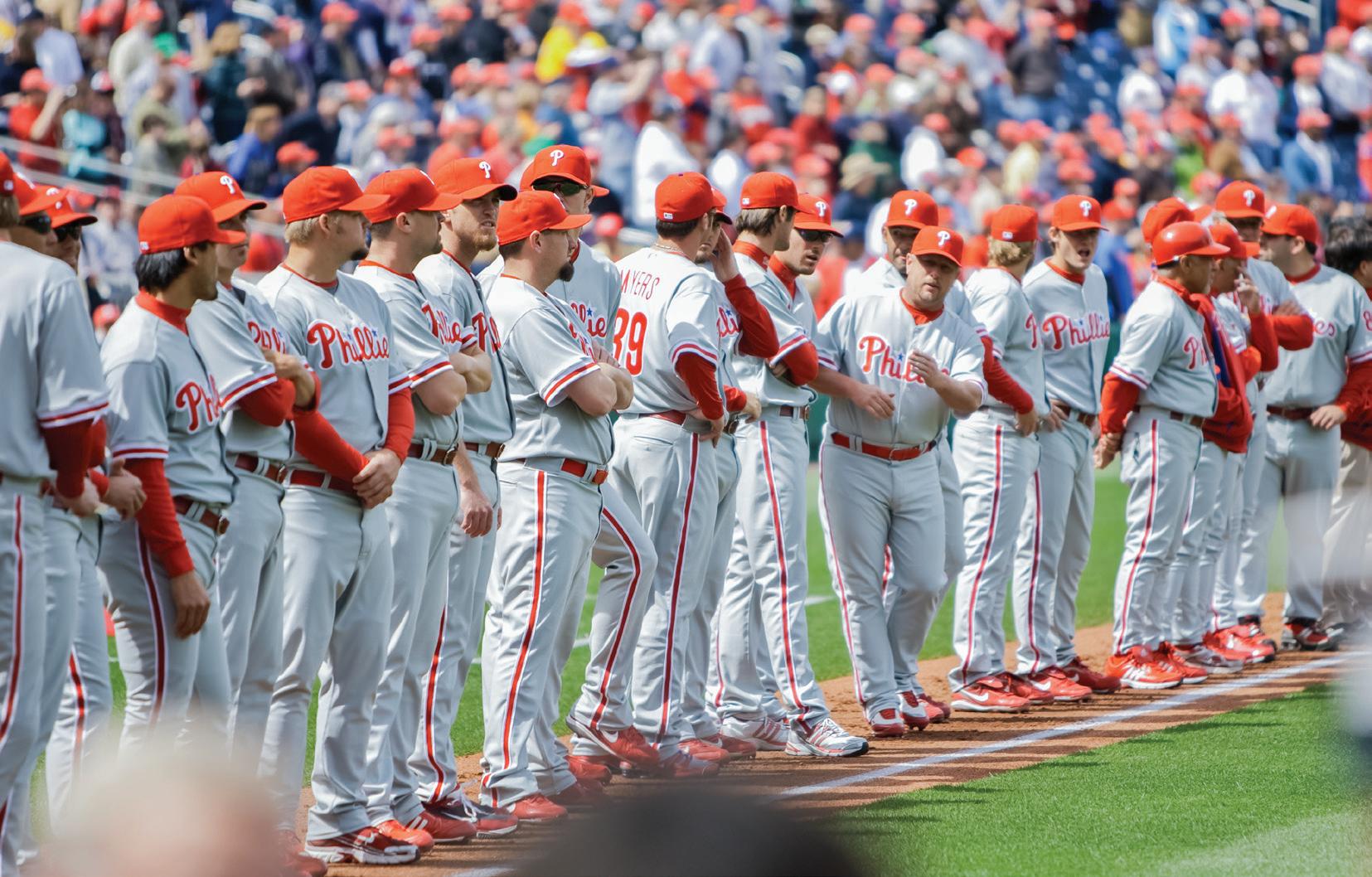
Teams set their sights on the October post-season.
■ With the most recent seeding released on Monday, Sept. 30, the playoffs picture is beginning to take shape.
By MILES GOLDSTEIN JUSTICE STAFF WRITER
better — and improving each week. Their most recent 42-14 thrashing of the Arizona Cardinals on Sept. 29 only further cements their place as a team to watch for the next few years, thanks to their stellar young quarterback.
While the Commanders are on the rise, the Jacksonville Jaguars are in total freefall. Their winless season stayed intact with a heart wrenching 24-20 loss in the final seconds against the Houston Texans, making their current record 0-4. Quarterback Trevor Lawrence has been the poster child of their futility, failing to lead their squad to victory since a win against the Texans on Nov. 26, 2023. While not expected to contend during the deep stages of the postseason, they have been projected to hold respectable 8-9 record wise. While there is a great deal of time remaining in the season for them to reverse this negative trend, prospects for the future for both Lawrence and the franchise are looking increasingly bleak.
Finally, the week’s primetime Sunday Night football game between the Baltimore Ravens and the Buffalo Bills did not involve a close contest, but rather complete domination by the Ravens in their 35-10 win. Ravens running back Derrick Henry was in his vintage form, running for an absurd 199 yards on 24 carries. In particular, his 87 yard touchdown run on the Ravens’ first offensive play of the game provided the momentum needed for them to get out in front and never look back. The
The 2024 Major League Baseball playoffs kick off with the wildcard round this Tuesday, Oct 1. In the American League, the third seeded Houston Astros will host the fifth seeded Kansas City Royals, while the fourth seeded Baltimore Orioles face off against the sixth seeded Detroit Tigers. The Cleveland Guardians will play the winner of the Astros/Royals game, and the top seeded Yankees will play the winner of the Orioles/Tigers game. Over in the National League, the third seeded Milwaukee Brewers will play the sixth seeded New York Mets, while the fourth seeded San Diego Padres play the fifth seeded Atlanta Braves. The top seeded Los Angeles Dodgers will play the winner of the Braves/ Padres game, and the Philadelphia Phillies will play the winner of the Brewers/Mets game.
After missing the playoffs in a disappointing 2023 season, the Yankees acquired right fielder Juan Soto from the Padres in a massive trade, and their pitching staff has put in some good work after struggling with injuries last year. But if anyone deserves the spotlight for New York this season, it’s center fielder Aaron Judge, who has put together an absurd offensive season and is a near-lock to win his second Most Valuable Player award.
It’s hard to call the Cleveland Guardians a surprise team this year, as they’ve made the playoffs six times since 2016. However, few expected them to be fighting for first place in the American League come October. Third baseman José Ramírez and first baseman Josh Naylor are standouts, as always. While starting pitching has been shaky at times, their bullpen, especially closer Emmanuel Clase, has helped the Guardians exceed expectations to this degree.
No one was prepared to count the Astros out — even as they floundered well into June — but one could be forgiven for wondering
if Houston had finally run out of gas after seven straight American League Champion Series appearances. However, any hopes for their demise were dashed when the Astros came roaring back in the second half of the season to claim their seventh division title in eight years. Regardless of how they’ve looked this year, they’re a team no one wants to face come October.
After a breakout season last year, the Orioles are proving that their progress is not a fluke. Their success this season has come from their talented young bats, led by shortstop Gunnar Henderson, and also thanks to a career-best year from right fielder Anthony Santander. They’ll be a dangerous team to face for any division winner, provided they beat their wildcard opponent.
The Kansas City Royals were one of the worst teams in baseball last year, but manager Matt Quatraro has this team playing like success is second nature. Were it not for Aaron Judge, shortstop Bobby Witt Jr. would likely be the American League MVP. The Royals don’t score a lot of home runs — they hit for contact and play good defense. They go into October with no expectations, which is the worst kind of team to face.
On Aug. 10, the Tigers were 55-63 after losing to the San Francisco Giants. Then they went 31-11 with a 4-1 win against the Chicago White Sox on Sept. 27. It is one of the most improbable end-of-season runs to make the playoffs in recent memory. While they’ve struggled offensively at times, starting pitcher Tarik Skubal has been electric and is a top contender for the American League’s Cy Young Award this year. They’re likely outmatched against the Orioles, but Detroit has gotten hot at the right time and that’s the key to October baseball.
The Brewers aren’t a flashy team, but that’s much of the reason for their success. They have an elite defensive infield and a great bullpen. They’re third in MLB in stolen bases and second in walks. It will be an uphill battle through the postseason without their best hitter, left fielder Christian Yelich, but they haven’t shown many signs of slowing down since losing him in August.
The Padres missed the playoffs, traded away arguably their most talented player and got better. It may not make sense, but there’s no denying the Padres’ success. Third baseman Manny Machado has been great, and they boast a two-headed pitching monster in Dylan Cease and Michael King. The Padres are built for October and are eyeing a potential playoff matchup against their longtime rivals, the Dodgers.
The Braves have had it rough with injuries. Last year’s National League MVP Ronald Acuña Jr. and starting pitcher Spencer Strider will miss the playoffs. However, starting pitcher Chris Sale and designated hitter Marcel Ozuna have put the team on their backs. Gio Urshela was a mid-season pickup at third base and has been a welcome contributor. The Braves have talent all over their roster, but depth will be an issue this postseason.
The Mets were one of the worst teams in the National league in late May. Something finally clicked, and they went 25-12 through late July, tying Houston for the best record over that stretch. Their starting pitching is good enough to keep them in games, especially when their bullpen has struggled at times. Shortstop Francisco Lindor has been great, but the 24-year-old third baseman Marcus Vientos has been the biggest standout.
The playoffs will run through October, with the World Series begin-
The Dodgers and two-way phenom Shohei Ohtani dominated the offseason news cycle, both for good and bad reasons, but it’s clear why Los Angeles gave Ohtani his recordbreaking 700 million dollar contract in spite of coming off Tommy John surgery. This season, Ohtani became the first player to record 50 home runs and 50 stolen bases. The Dodgers have had everything needed to make a World Series run for years. Now, the expectations have never been higher. The Phillies lost the World Series in 2022 and were a game away from returning in 2023. This season, they’re back doing what they do best: overwhelming teams with offensive firepower. But this year, their much-improved defense has made them a complete team. Add in a career-best year from starting pitcher Zach Wheeler and the Phillies are a formidable force to capture the National League pennant.

On a chilly Tuesday evening, Boston University Radio and the Rose Art Museum collaborated in curating a public forum and conversation surrounding Hugh Hayden and his collection “Home Work.” The conversation, held at WBUR City Space in Boston on Sept. 24, started promptly at 6 p.m. as journalist and artist Arielle Gray led the conversation surrounding Hayden’s work as it pertains to Black and brown communities.
Hayden is a visual installation artist who has been featured in the New York Times and The Washington Post. His collection opened at the Rose Art Museum on Sept. 20 and is set to stay up until June 2025. Before he became a surrealist artist, he studied architecture at Cornell University. After he graduated, he attended Columbia University for his Masters in Fine Arts. Hayden’s work in architecture naturally often guides his installations. Wood is his primary medium, often taking the form of public displays and large exhibitions in America and globally.
Hayden grew up in the majority-minority city of Dallas, Texas which deeply influences his work. Gray mentioned that his work “pulls on threads of his personal life but is not always autobiographical.” The focus of his current exhibition is to craft sculptures out of wood that focus conversations around education. He admitted that while he is not a historian he is “constantly remixing the past and present.”
His work authentically questions the relationship between Black folks and the American Dream. Gray introduced the piece “Gulf Stream” which is a public display in the Boston Navy yard. This piece is an explicit exploration of forced enslavement, the Black struggle for survival and the African Diaspora. Hayden’s “Gulf Stream” was created in direct reference to Winslow Homer’s ‘Gulf Stream’ painting. The 1899 oil painting depicts a young Black man in a small boat fighting the stormy waves and surrounded by sharks. Homer
By MINA ROWLAND JUSTICE ASSOCIATE EDITOR
acknowledged the implications of imperialism and the slave trade. Similarly, Hayden also explores themes of the commodification of Black people referencing their commodification through the ship.
His work is a large boat carved from Atlantic Cedar and White Oak. The intricate details lie on the inside of the boat — carved into the deck is a skeletal spine. Hayden explained, “The boat is a representation of life, literally. It is a vessel to carry life... and boats are very anthropomorphic in the way they are built as a container.”
One of his most prominent and largest displays is “Brier Patch,” in which a series of elementary school chairs [are assembled]. These chairs, however, are half-chair and half-tree with branches extending naturally from it. At first sight, one may assume that the branches are affixed in some way to the chairs but they are not.
“Christmas is a cultural tradition that is really a mass sacrifice of trees” he laughed as he explained he rescued New York City trees. “I would find the ones that lined the streets to use for carving,” Hayden added. The trees often would be discarded so this was not only a way to recycle but a way to transform ordinary objects into extraordinary artworks. Incredibly, this means that each chair is a tree and the branches are completely natural; they are one and the same.
Hayden began creating the “Brier Patch” display during his time earning his MFA at Columbia University. Now it is a traveling set of chairs that portray a complex and layered interpretation of the American Dream. Education, of course, is often seen as the one aspect that can level the playing field. Hayden wants observers to consider the inequity that is faced within the education system for Black individuals.
The use of magical realism and fantasy is also interwoven into his work. “Huff and a Puff” is an installation of a slanted, ex
where he wrote “Walden” in 1845. The dramatic slanted wood and bricks combine the literal with elements of surrealism. During the interview, Hayden talked about the role of magical storytelling in art.
He delighted the audience, balancing humor and creative energy as Gray asked him about his creative process. One of her questions to Hayden regarded his piece called “Walden,” which is a distorted school chair that emulates a “Huff and a Puff.” “Creating a sculpture that changes perspective as you walk around it was important,” Hayden explained. He noted that not only is there a metaphor around perspective but that he intentionally uses wood to make works that engage the senses of the audience. The slanted chair contains an attached desk on which the outside cover reads “The Life and Times of Frederick Douglass” but the inside is a copy of Henry David Thoreau’s book.
Themes in his works that he mentioned multiple times during the interview were anthropomorphic structures and the use of homogenization. This is illustrated in his work “American Gothic.” This piece is one of the most anthropological in the sense of form. It emulates the original Grant Wood piece in that it contains two figures. However, these two figures in Hayden’s creation are headless skeletons. They are made from wood but also contain farmhand and cleaning objects such as a pitchfork and shovel or a mop and duster to represent the hands or feet on the skeletons. Several aspects of this piece stand out. Hayden mentions that there is a sense of anonymity regarding skeletons, especially if you are unfamiliar. “You do not get a sense of race or class based on a skeleton,” Hayden explained. He centered the conversation around labor, domesticity and pure existence. This piece speaks volumes through its various interpretations.
The branches, the thorns and the anthro
American Dream means to different individuals. “People can see themselves or it exposes them to something they may not understand,” Hayden said of his work as the evening came to a close. The conversations concluded with the themes of the American dream and the ways in which he explores the harsh reality of what it means to try to inhabit such a dream.
As an artist and journalist myself, my initial reaction to Hayden’s work is that it balances being both unsettling and uncomfortable while also being brilliant and bold. As the interview concluded, I reflected on my own art and what ways socio-political messages are in my own work. Hayden’s work has certainly inspired me to use everyday materials and turn them into a powerful and iconic message. I was not alone in receiving inspiration from the interview. Several attendees took pictures of his work throughout the presentation and a few students had the opportunity to ask questions at the end. The audience seemed equally interested in Hayden’s work now and his impact in the future.
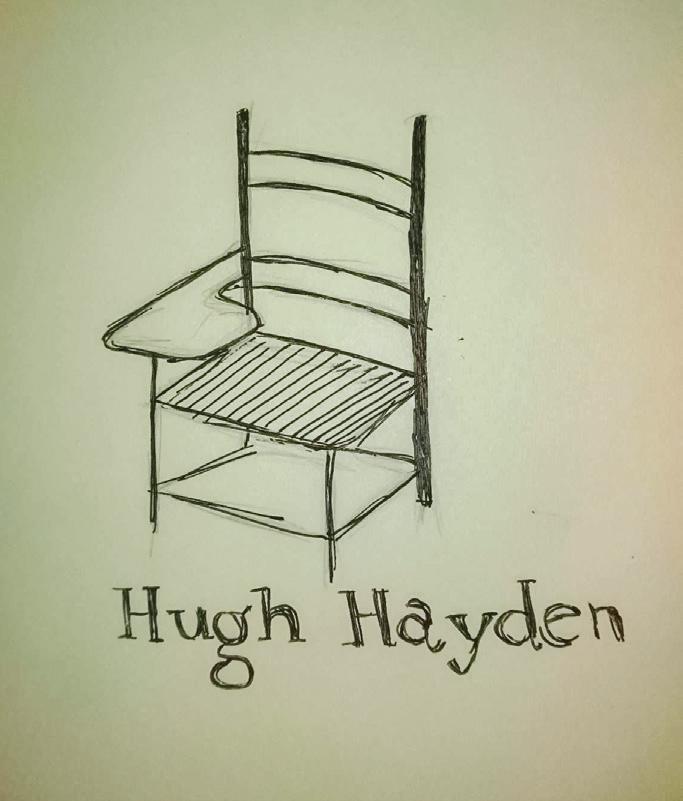

By DAHLIA RAMIREZ JUSTICE STAFF ARTIST

By LAUREN GOODMAN AND IYLA LICHTENFELD JUSTICE CONTRIBUTING WRITERS
Brandeis’ Craft Market returned to campus on Saturday Sept. 28 as booths of students and local artists populated the Fellows Garden. Pottery, keychains, crochet and illustrations showcased the unique skills of new and returning sellers. Though the event leadership recently changed to the Brandeis Art Club, the new forces behind it show that the community’s dedication to the arts is difficult to squash.
Before now, the Craft Market was led by Ingrid Schorr, the former director of Arts Engagement and Communications at the University. Unfortunately, the program has been discontinued, leaving student artists concerned for the future. Despite logistical challenges, the Craft Market returned for family and alumni weekend. Students like Angel Zhao ’25, who has sold illustrations at the market since her first year at Brandeis, shared how “the transition process has been a little bit confusing” but she is “fortunate enough to still participate.” On the other hand, studio art major Tako Mikhelashvili ’26, who is selling pottery at the Craft Market for the first time, felt more optimistic. Mikhelashvili shared, “so far it’s going pretty good I think. The location is great … I think it’s a very good opportunity for students who are into arts and crafts to show the stuff that they make … and it gives them an opportunity to sell their stuff.”

With the end of Arts Engagement, the Art Club successfully took over and got the Craft Market running this year. Without the faculty structure and funding of Brandeis Arts Engagement, setup and artist applications have been more complicated compared to previous years. Nonetheless, the Art Club is supporting artists where Brandeis administrators seemed to have stopped. Hence, part of the market that cannot be ignored is the dedication and salesmanship of each individual artist. For instance, Sam Pollock

’24, a senior graduating in December, started their Perler Bead business last fall after getting inspired by a community advisor event. This is their second time at the market after selling keychains, though they found that “the effort to output was not worth it.”
This year, Pollock sees their new craft as “[their] way to destress.” “I love doing this, and I can make a lot of products,” they shared.
Shelly Kidron ’24, who graduated last spring, is now using her “side hobby” of painting and drawing to open an Etsy shop. She originally gave out her illustrations as “gifts for friends,” with each painting “curated … to somebody’s personality.” Soon enough Kidron realized the potential of expanding to print copies, and has since run a booth at the Craft Market for the past three years. When asked why she returned to the Craft Market after graduating, Kidron said: “It’s just a great experience, and also I have other friends here that are selling … The Art Club also collaborated with me, invited me back, and it was such a big part of my personality and everything … It’s great reconnecting with alumni, it’s community.”
The end of the Brandeis Arts Engagement program has undoubtedly left many student artists feeling uneasy about the future of the arts at Brandeis. However, the support of student-led organizations such as the Art Club provides hope that creative arts at this university will continue to thrive.
CINEMA CRITIQUE
By LUCAS THOMPSON JUSTICE CONTRIBUTING WRITER
One of the most celebrated pieces in film history, Stanley Kubrick’s “2001: A Space Odyssey” — based on Arthur C. Clarke’s book of the same name — is revered as a technical wonder and exists in an interesting contrast to his other, often grotesque or disturbing films. The science fiction movie is essentially a story of progress and evolution, beginning with our ape ancestors and taking us well into the future of humanity. Here is a spoiler-free review of my favorite movie of all time!
One cannot discuss “2001” without mentioning the absolute artistry of it, not just as a meaningful story but as a visual masterpiece. Possibly the most famous shot from the film is of astronaut protagonist, David Bowman, space-suited up and walking down the white corridor of his ship. It is a beautiful shot, and the film is filled with other cinematic feats such as this: wide shots of massive spaceships, which in reality are incredibly detailed and impressive models; gorgeous desert landscapes and skillfully set up symmetrical shots that are incredibly pleasing on the eye. I’d highly recommend watching this movie on as large of a screen as possible — with good speakers too, as you want to fully enjoy the presence of “2001’s” famous theme: “Also sprach Zarathustra” (if you think you haven’t heard it, you definitely have!). Classical orchestral music permeates the film, creating an iconic fusion of the past and the future. In short, the visuals and music work together to create a truly majestic film.
“2001” isn’t just a vision of the future, though; while the film is about the evolution of humankind, in hindsight it also serves as a sort of artifact, capturing a unique time in American culture and history. For instance, the space shuttles seen at the beginning of the movie are notably branded with the Pan American Airways logo. This small detail is significant when you note that while Pan American was the most successful airline of the 1900s and a pioneer of the industry, it is no longer around. From the perspective of the 1960s filmmakers, what other brand could possibly make the leap into space travel than the luxurious Pan American? Of course now, this is just a relic of the past, but immortalized in the film.
Speaking of the 1960s, the making and release of this film fell during an especially significant time in U.S history: “2001” was released in 1968, one year before the moon landing and right in the middle of the Cold War. The film captures the essence of this time; a profound excitement for the future of space travel and technology, but also a de -
sire for world powers to collaborate on these endeavors. At the start of the film, Russian and American scientists are shown to not just be colleagues, but also great friends. At the time of this film’s release, the Soviet Union and the United States were in the midst of a heated competition deciding which power would be at the forefront of space exploration. “2001” paints an alternative picture of scientific partnership which sends a strong political signal even today.
The message of “2001: A Space Odyssey” is deeply meaningful. It is an appreciation for the skills and spirit of humanity, a caution against ourselves and what our own creations can do to us and a hopeful reminder that as a species we will continue to grow and change for the better! To me, the film also gives a greater meaning to the universe, creating a world that is held together by something not necessarily comprehensible but there nonetheless.


By Ariana Rich JUSTICE EDITORIAL ASSISTANT
Honorable mention: Speartooth Shark
“I want love. I want it badly.”
I also want to be loved. But who am I to be loved?
I try to be pretty and beautiful and confident. But at the end of the day, the self is a different shape in the mirror everyday, and every space.
I’m a clump of Play-Doh for others to play with, and they smile.
A pretty arrangement that only blooms in the sight of others, and I wilt away after.
I crave the applause I want to be seen, no matter the mold I must fill. Yet I hate being admired. No praise for an incomplete piece of self.
Hearing a single compliment makes me want to cover my head, forever. Because I never know what to say after I laugh my cheeks flash shades of a blazing furnace. I think I’m on fire.
One day, I want to mold myself, with my hands, no other, on the clay of self.
I might become a week old arrangement in a paper bunch, some petals cut and the stem is a little browned, But at last, my shape remains steady in the mirror.
And so I no longer try confidence on, I submerge my entirety in it.
Elle Yung ’28 is an intended Biology major and Women and Gender Studies minor. She has been writing poetry for four years now and considers it a deeply personal art. Yung tends to be inspired by aspects of her own identity — being a transgender athlete and having hidden disabilities — along with her personal life experiences. This work was inspired by a poem she heard at an open mic in New York City and is part of a 5fivepoem collection about the different shades of relationships. If you are interested in reading other works by Yung, please reach out to her at elleyung@brandeis.edu
By NEMMA KALRA JUSTICE EDITOR
